Sony A3880017 GSM 850/900/1800/1900 GPRS/EDGE/UMTS FDD1&2&5 HSDPA mobile phone with Bluetooth, A-GPS, FM receiver User Manual Sony Ericsson Mobile Communications AB
Sony Mobile Communications Inc GSM 850/900/1800/1900 GPRS/EDGE/UMTS FDD1&2&5 HSDPA mobile phone with Bluetooth, A-GPS, FM receiver Sony Ericsson Mobile Communications AB
Sony >
Contents
- 1. 08 user manual
- 2. Users Manual
Users Manual

Contents
Getting started......................6
Assembly............................................6
Turning on the phone.........................6
Help....................................................7
Charging the battery..........................7
Phone overview..................................9
Menu overview.................................11
Navigation........................................13
Memory............................................14
Phone language...............................15
Entering text.....................................15
Walkman™ .........................16
Stereo portable handsfree...............16
Walkman™ player............................17
TrackID™ and MusicID™ ................20
Video player.....................................20
FM radio ..........................................21
MusicDJ™........................................22
Record sound ..................................22
AT&T Music......................................22
Transferring and
handling content.................23
Handling content in the phone.........23
Sending content to another
phone...............................................24
Using the USB cable........................24
Transferring content to and from
a computer.......................................26
Phone name.....................................28
Using Bluetooth™ wireless
technology........................................28
Backing up and restoring.................29
Calling..................................30
Making and receiving calls...............30
Address Book ..................................32
Speed dial........................................35
More calling features........................36
Messaging...........................39
Text and multimedia messages.......39
Conversations..................................40
Voice messages...............................41
Mobile Email.....................................41
Instant Messaging (IM).....................41
Imaging ...............................43
Using the camera.............................43
More camera features......................44
1
This is a draft publication for internal use only.

Camera tips and tricks.....................45
Viewing and tagging photos............45
Using photos....................................46
Working with photos........................46
Printing photos.................................47
MEdia™ Net........................48
Bookmarks.......................................48
History pages...................................48
More browser features.....................48
Internet security and certificates......49
Synchronising.....................50
Synchronising using a computer.....50
More features......................51
Flight mode......................................51
Gesture control................................51
Alarms..............................................52
Calendar...........................................53
Notes................................................53
Tasks................................................54
Profiles.............................................54
Time and date..................................54
Theme..............................................55
Main menu layout.............................55
Ringtones.........................................55
Screen orientation............................55
Games..............................................56
Applications.....................................56
Locks................................................56
Password Saver ..............................58
IMEI number.....................................58
Using the flip....................................59
Troubleshooting..................59
Common questions..........................59
Error messages................................62
Hearing Aid Compatibility...63
Hearing Aid Settings........................63
Hearing Aid Compatibility and
New Technologies............................63
Hearing Aid Compatibility Rating.....64
Index....................................65
2
This is a draft publication for internal use only.

Sony Ericsson W518a Walkman™
This User guide is published by Sony Ericsson
Mobile Communications AB or its local affiliated
company, without any warranty. Improvements and
changes to this User guide necessitated by
typographical errors, inaccuracies of current
information, or improvements to programs and/or
equipment, may be made by Sony Ericsson Mobile
Communications AB at any time and without notice.
Such changes will, however, be incorporated into
new editions of this User guide.
All rights reserved.
©Sony Ericsson Mobile Communications AB, 2009
Publication number:
Attention: Some of the services and features
described in this User guide are not supported by
all networks and/or service providers in all areas.
Without limitation, this applies to the GSM
International Emergency Number 112. Please
contact AT&T or your service provider to
determine availability of any specific service or
feature and whether additional access or usage
fees apply.
Please read the Important information before you
use your mobile phone.
Your mobile phone has the capability to download,
store and forward additional content, e.g. ringtones.
The use of such content may be restricted or
prohibited by rights of third parties, including but not
limited to restriction under applicable copyright
laws. You, and not Sony Ericsson, are entirely
responsible for additional content that you
download to or forward from your mobile phone.
Prior to your use of any additional content, please
verify that your intended use is properly licensed or
is otherwise authorized. Sony Ericsson does not
guarantee the accuracy, integrity or quality of any
additional content or any other third party content.
Under no circumstances will Sony Ericsson be liable
in any way for your improper use of additional
content or other third party content.
Smart-Fit Rendering is a trademark or a registered
trademark of ACCESS Co., Ltd.
Bluetooth is a trademark or a registered trademark
of Bluetooth SIG Inc. and any use of such mark by
Sony Ericsson is under license.
The Liquid Identity logo, SensMe, MusicDJ,
PhotoDJ, TrackID and VideoDJ are trademarks or
registered trademarks of Sony Ericsson Mobile
Communications AB.
TrackID™ is powered by Gracenote Mobile
MusicID™. Gracenote and Gracenote Mobile
MusicID are trademarks or registered trademarks of
Gracenote, Inc.
WALKMAN, WALKMAN logo, Sony, Memory Stick
Micro™ and M2™ are trademarks or registered
trademarks of Sony Corporation.
Media Go is a trademark or registered trademark of
Sony Media Software and Services.
PictBridge is a trademark or registered trademark of
Canon Kabushiki Kaisha Corporation.
Style-Up is a trademark or registered trademark of
Sony Ericsson Mobile Communications AB.
MEdia is a trademark or registered trademark of ATT
Mobility.
Yahoo! Is a trademark or a registered trademark of
Yahoo! Inc.
AOL and AIM are trademarks or registered
trademarks of AOL LLC.
AT&T is a registered trademark of AT&T Corporation.
Ericsson is a trademark or registered trademark of
Telefonaktiebolaget LM Ericsson.
Adobe Photoshop Album Starter Edition is a
trademark or registered trademark of Adobe
Systems Incorporated in the United States and/or
other countries.
Microsoft, ActiveSync, Windows, Outlook, Windows
Media and Vista are registered trademarks or
trademarks of Microsoft Corporation in the United
States and/or other countries.
3
This is a draft publication for internal use only.

T9™ Text Input is a trademark or a registered
trademark of Tegic Communications. T9™ Text
Input is licensed under one or more of the following:
U.S. Pat. Nos. 5,818,437, 5,953,541, 5,187,480,
5,945,928, and 6,011,554; Canadian Pat. No.
1,331,057, United Kingdom Pat. No. 2238414B;
Hong Kong Standard Pat. No. HK0940329; Republic
of Singapore Pat. No. 51383; Euro.Pat. No. 0 842
463(96927260.8) DE/DK, FI, FR, IT, NL, PT, ES, SE,
GB; and additional patents are pending worldwide.
This product is protected by certain intellectual
property rights of Microsoft. Use or distribution of
such technology outside of this product is prohibited
without a license from Microsoft.
Content owners use Windows Media digital rights
management technology (WMDRM) to protect their
intellectual property, including copyrights. This
device uses WMDRM software to access WMDRM-
protected content. If the WMDRM software fails to
protect the content, content owners may ask
Microsoft to revoke the software's ability to use
WMDRM to play or copy protected content.
Revocation does not affect unprotected content.
When you download licenses for protected content,
you agree that Microsoft may include a revocation
list with the licenses. Content owners may require
you to upgrade WMDRM to access their content. If
you decline an upgrade, you will not be able to
access content that requires the upgrade.
This product is licensed under the MPEG-4 visual
and AVC patent portfolio licenses for the personal
and non-commercial use of a consumer for (i)
encoding video in compliance with the MPEG-4
visual standard ("MPEG-4 video") or the AVC
standard ("AVC video") and/or (ii) decoding MPEG-
4 or AVC video that was encoded by a consumer
engaged in a personal and non-commercial activity
and/or was obtained from a video provider licensed
by MPEG LA to provide MPEG-4 and/or AVC video.
No license is granted or shall be implied for any other
use. Additional information including that relating to
promotional, internal and commercial uses and
licensing may be obtained from MPEG LA, L.L.C.
See http://www.mpegla.com. MPEG Layer-3 audio
decoding technology licensed from Fraunhofer IIS
and Thomson.
Java, JavaScript and Java-based trademarks and
logos are trademarks or registered trademarks of
Sun Microsystems, Inc. in the U.S. and other
countries.
End-user license agreement for Sun Java Platform,
Micro Edition.
1. Restrictions: Software is confidential copyrighted
information of Sun and title to all copies is retained
by Sun and/or its licensors. Customer shall not
modify, decompile, disassemble, decrypt, extract,
or otherwise reverse engineer Software. Software
may not be leased, assigned, or sublicensed, in
whole or in part.
2. Export regulations: This product, including any
software or technical data contained in or
accompanying the product, may be subject to
import and export regulations of the European
Union, the United States and other countries. The
user and any possessor of the product agrees to
comply strictly with all such regulations and
acknowledges that it is their responsibility to obtain
any required licenses to export, re-export, or import
this product. Without limiting the foregoing, and as
an example, the user and any possessor of the
product: (1) must not knowingly export or re-export
Products to destinations identified pursuant to
Articles in Chapter II of European Council Regulation
(EC) 1334/2000; (2), must comply with U.S.
government Export Administration Regulations
("EAR", 15 C.F.R. §§ 730-774, http://
www.bis.doc.gov/ ) administered by Department of
Commerce, Bureau of Industry and Security; and (3)
must comply with economic sanctions regulations
(30 C.F.R. §§ 500 et. seq.,., http://www.treas.gov/
offices/enforcement/ofac/) administered by the U.S.
Department of Treasury, Office of Foreign Assets
Control. The user and any possessor of the product
4
This is a draft publication for internal use only.

may not transport or deliver the product, its
accessories or separate software to any country,
region, entity or person prohibited by these
regulations.
Restricted Rights: Use, duplication or disclosure by
the United States government is subject to the
restrictions as set forth in the Rights in Technical
Data and Computer Software Clauses in DFARS
252.227-7013(c) (1) (ii) and FAR 52.227-19(c) (2) as
applicable.
Other product and company names mentioned
herein may be the trademarks of their respective
owners.
Any rights not expressly granted herein are reserved.
All illustrations are for illustration only and may not
accurately depict the actual phone.
Your phone is designed to make it easy for you to
access a wide variety of content. For your
protection, we want you to be aware that some
applications that you enable may involve the
location of your phone being shared. For
applications available through AT&T, we offer
privacy controls that let you decide how an
application may use the location of your phone and
other phones on your account. However, the AT&T
privacy tools do not apply to applications available
outside of AT&T. Please review the terms and
conditions and the associated privacy policy for
each location-based service to learn how location
information will be used and protected. In addition,
your AT&T phone may be used to access the Internet
and to download, and/or purchase goods,
applications, and services from AT&T or elsewhere
from third parties. AT&T provides tools for you to
control access to the Internet and certain Internet
content. These controls may not be available for
certain devices which bypass AT&T controls.
Instruction symbols
These symbols may appear in the User
guide.
Note
Tip
Warning
>Use a selection or navigation key to
scroll and select. See Navigation on
page 13.
5
This is a draft publication for internal use only.
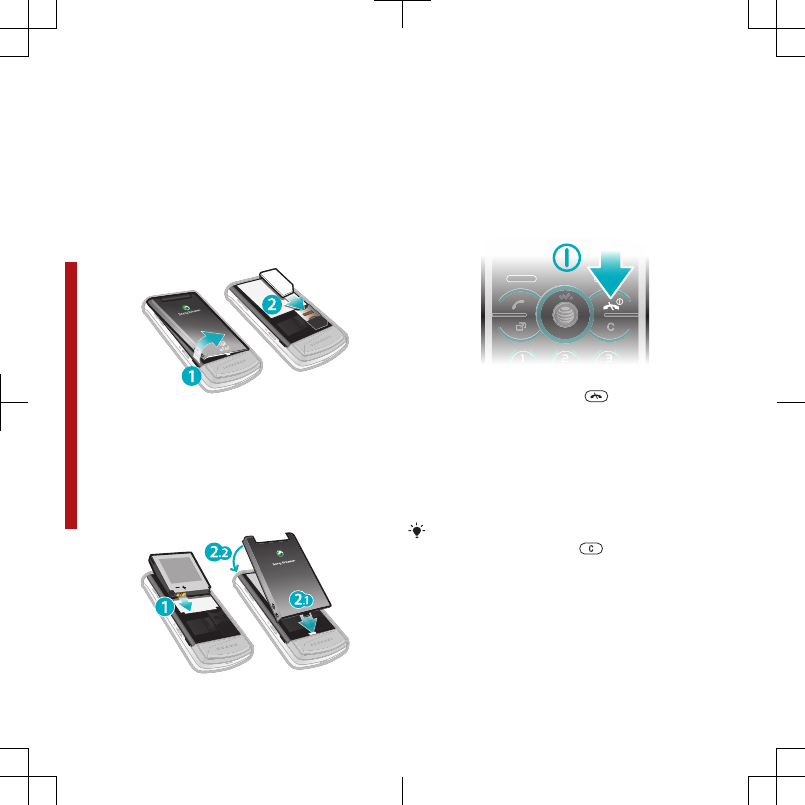
Getting started
Assembly
Before you start using your phone, you
need to insert a SIM card and the
battery.
To insert the SIM card
1Remove the battery cover.
2Slide the SIM card into its holder with
the gold-coloured contacts facing
down.
To insert the battery
1Insert the battery with the label side up
and the connectors facing each other.
2Attach the battery cover.
Turning on the phone
To turn on the phone
1Press and hold down .
2Enter your SIM card PIN, if requested,
and select OK.
3Select a language.
4Follow the instructions to use the setup
wizard for basic settings and useful
tips.
If you want to correct a mistake when you
enter your PIN, press .
SIM card
When you register as a subscriber with
AT&T, you get a SIM (Subscriber
Identity Module) card, which contains
information about your subscription.
Always turn off your phone and detach
6Getting started
This is a draft publication for internal use only.

the charger before you insert or remove
the SIM card.
You can save contacts on the SIM card
before you remove it from your phone.
See To copy names and numbers to the
SIM card on page 34.
PIN
You may need a PIN (Personal
Identification Number) to activate the
services and functions in your phone.
Your PIN is supplied by AT&T. Each
PIN digit appears as *, unless it starts
with emergency number digits, for
example, 112 or 911. You can see and
call an emergency number without
entering a PIN.
If you enter the wrong PIN three times in
a row, the SIM card is blocked. See SIM
card lock on page 56.
Standby
After you have turned on your phone
and entered your PIN, the name of the
network operator appears. This view is
called standby. Your phone is now
ready for use.
Using other networks
Making and receiving calls, using
messaging, and data transfer, for
example, Internet-based services,
outside your home network (roaming),
may incur additional costs. Contact
your operator for more information.
Help
In addition to this User guide, Feature
guides and more information are
available at
www.sonyericsson.com/support.
Help and information are also available
in your phone.
To view information about functions
•Scroll to a function and select Info, if
available. In some cases, Info appears
under Options.
To view the phone status
•Select Menu > Settings > General >
Phone status.
Charging the battery
The phone battery is partly charged
when you buy it.
Getting started 7
This is a draft publication for internal use only.

To charge the battery
1Connect the charger to the phone. It
takes approximately 2.5 hours to fully
charge the battery. Press a key to view
the screen.
2Remove the charger by tilting the plug
upwards.
You can use your phone while it is
charging. You can charge the battery at
any time and for more or less than 2.5
hours. You can interrupt the charging
without damaging the battery.
8Getting started
This is a draft publication for internal use only.
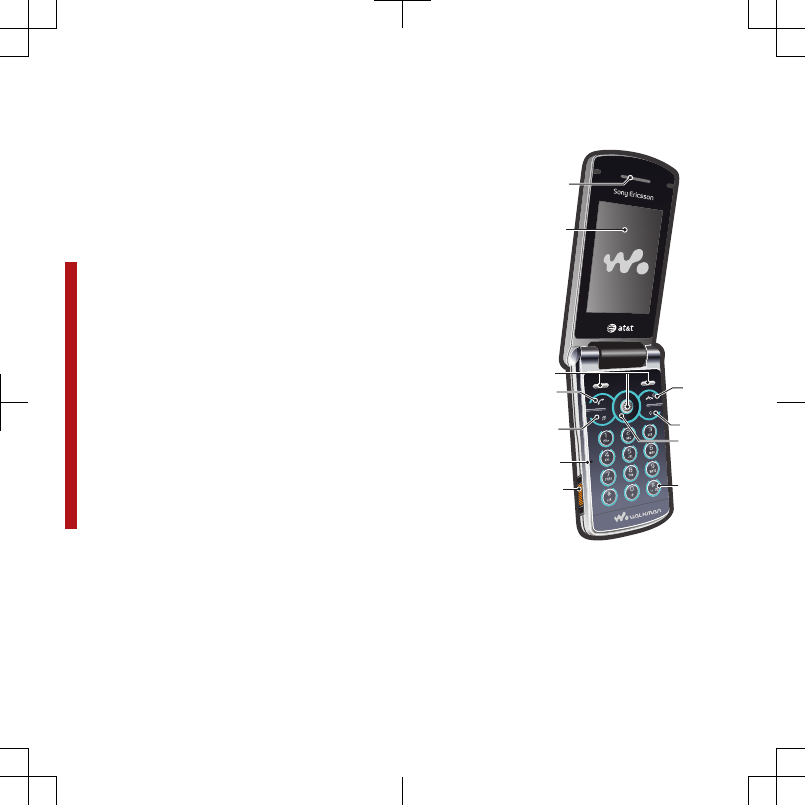
Phone overview
1 Ear speaker
1
2
3
4
5
6
7
8
9
10
11
2 Screen
3 Selection keys
4 Call key
5 Activity menu key
6 Microphone
7 Connector for charger, handsfree and USB cable
8 End key, On/off key
9 C key (Clear)
10 Navigation key
11 Silent key
Getting started 9
This is a draft publication for internal use only.
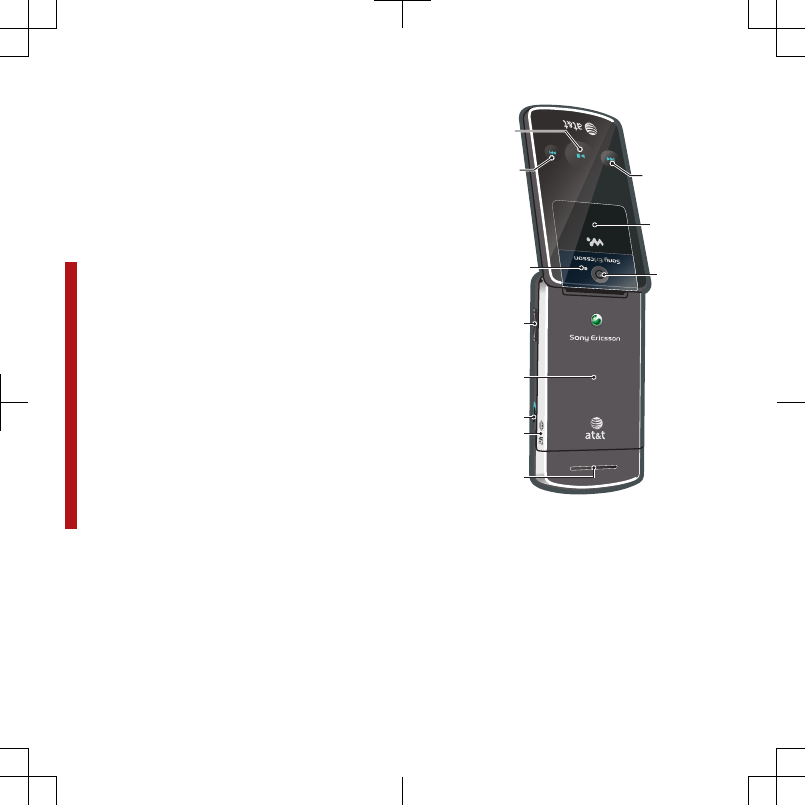
12 Media player key - play/stop
21
20
22
16
17
18
15
13
14
19
12
13 Media player key - next/fast forward
14 Screen light sensor
15 Volume, digital zoom keys
16 Battery cover
17 Keylock switch
18 Memory Stick Micro™ (M2™) slot
19 Loudspeaker
20 Media player key - previous/rewind
21 External display
22 Main camera
10 Getting started
This is a draft publication for internal use only.
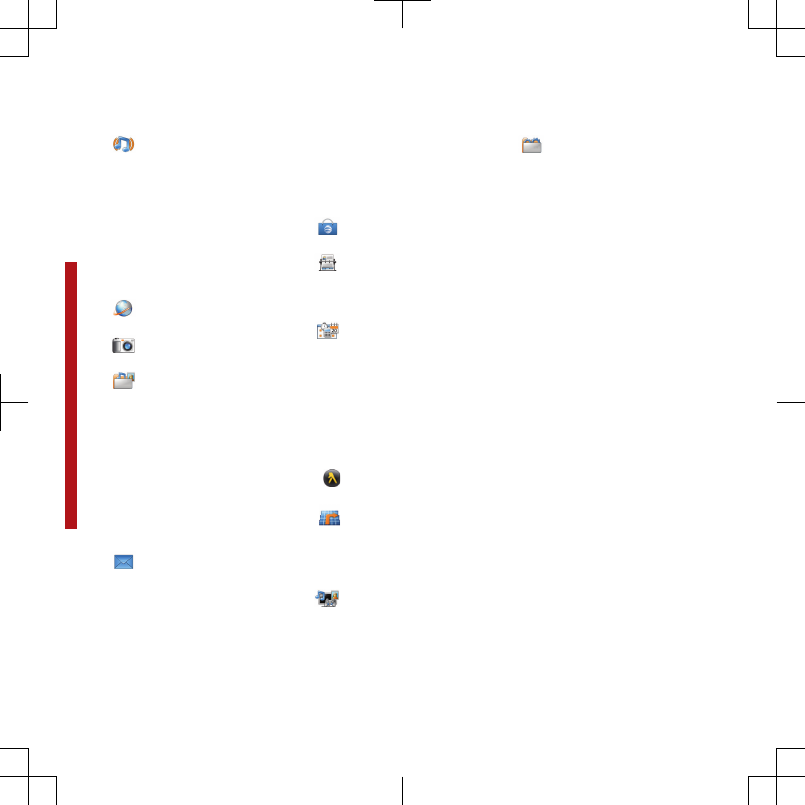
Menu overview
AT&T Music
WALKMAN
Shop Music
Music ID
XM Radio
Music Videos
Make-UR-Tones
Community
Music Apps
MEdia Net
Camera
My Stuff
Camera album
Music
Pictures
Video
Themes
Web pages
Games
Applications
Other
Messaging
Write new
Inbox/Conversations
Mobile Email
IM*
Call voicemail
Sent messages
Drafts
Saved messages
Templates
Manage messages
Settings
MEdia Mall
Address Book
Myself
New contact
Tools & Apps
Applications
Tools
Organiser
Alarms
FM Radio
Record sound
Recent Calls
Yellow Pages
AT&T GPS
AT&T Navigator
Where
Shop GPS Apps
Entertainment
Photo
Music
Video
Games
Settings
Settings
General
Profiles
Time & date
Language
Gesture control
Software Update ***
Voice control
New events
Shortcuts
Flight mode
Security
Setup wizard
Accessibility
Phone status
Master reset
Sounds & alerts
Ring volume
Ringtone
Silent mode
Increasing ring
Vibrating alert
Message alert
Key response
Display
Wallpaper
Main menu layout
Theme
Screen saver
Clock size
Brightness
Calls
Speed dial
Smart search
Getting started 11
This is a draft publication for internal use only.

Forward calls
Manage calls
Video Share*
Time & cost*
Show/hide my no.
Handsfree
Open to answer
Connectivity
Bluetooth
USB
GPS
Phone name
Mobile networks***
Internet settings
Streaming settings
Message settings*
SIP settings
IMS settings
Accessories
* Some menus are operator-,
network- and subscription-
dependent.
*** Menu appears only when
available.
12 Getting started
This is a draft publication for internal use only.
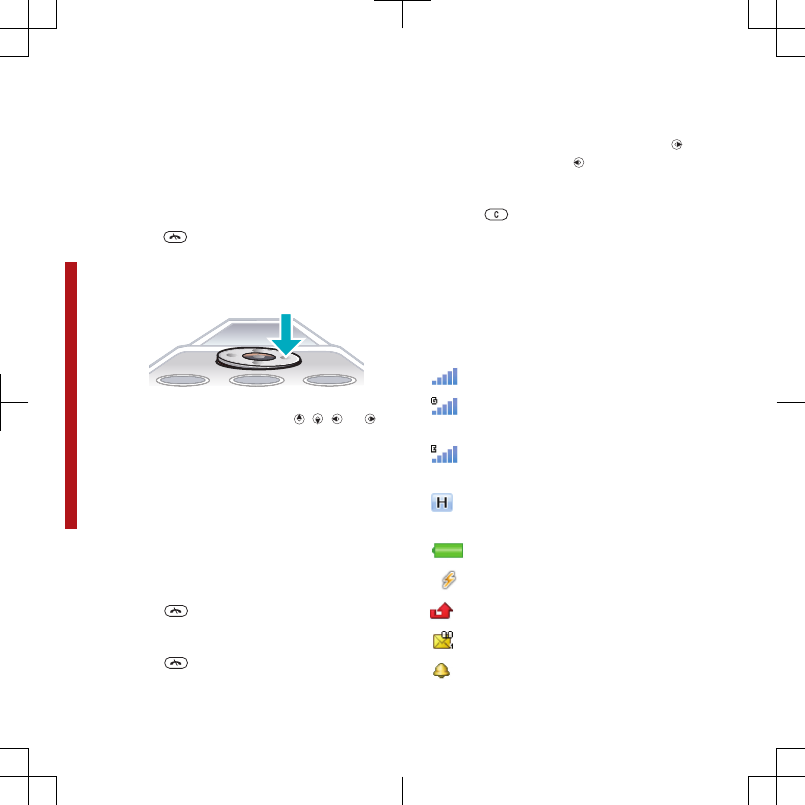
Navigation
To access the main menu
•When Menu appears on the screen,
press the right selection key to select
Menu.
•If Menu does not appear on the screen,
press , and then press the right
selection key to select Menu.
To navigate the phone menus
•Press the navigation key , , or to
move through the menus.
To select actions on the screen
•Press the left, centre or right selection
key.
To view options for an item
•Select Options to, for example, edit.
To end a function
•Press .
To return to standby
•Press .
To navigate your media
1Select Menu > Entertainment.
2Scroll to a menu item and press .
3To go back, press .
To delete items
•Press to delete items such as
numbers, letters, pictures and sounds.
Status bar icons
You may see icons in the standby
screen of your phone.
Icon Description
GSM network signal strength
GPRS network is within range
and can be used
EDGE network is within range
and can be used
HSDPA network is within range
and can be used
Battery strength indicator
Battery is charging
Missed incoming call
Voicemail waiting
Alarm is set and turned on
Getting started 13
This is a draft publication for internal use only.
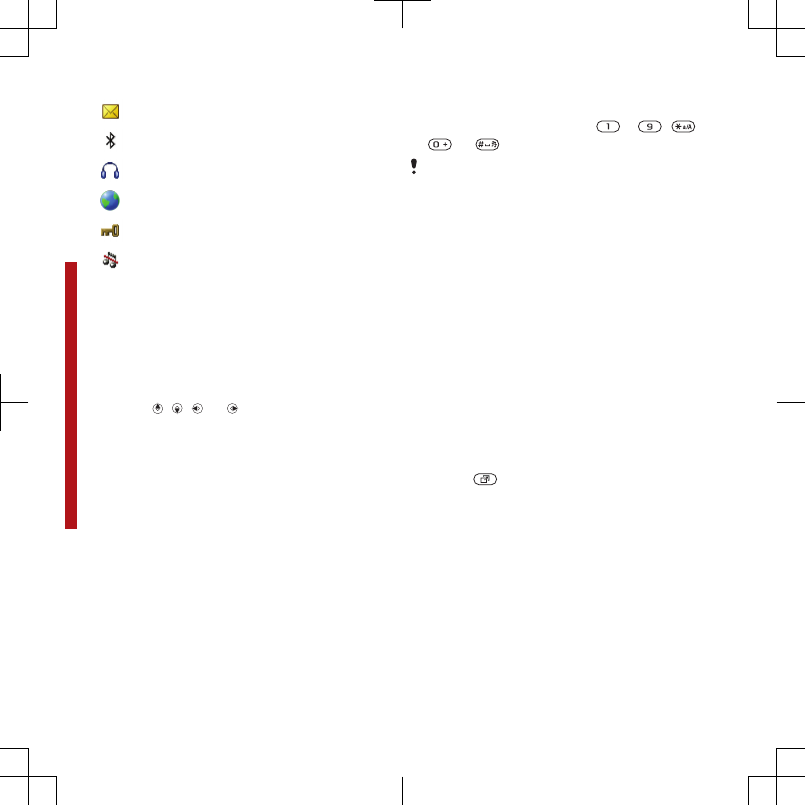
Text messaging waiting
Bluetooth is turned on
Headphones are attached
Internet session is active
Keylock is on
Silent mode is on
Shortcuts
You can use keypad shortcuts to go
directly to functions from standby.
To use navigation key shortcuts
•Press , , or to go directly to a
function.
To edit a navigation key shortcut
1Select Menu > Settings > General >
Shortcuts.
2Scroll to an option and select Edit.
3Scroll to a menu option and select
Shortc..
Main menu shortcuts
Menu numbering starts from the top left
icon and moves across and then down
row by row.
To go directly to a main menu item
•Select Menu and press – , ,
or .
The Main menu layout must be set to
Grid. See To change the main menu
layout on page 55.
Activity menu
The activity menu gives you quick
access to:
•New events – missed calls and new
messages.
•Running apps – applications that are
running in the background.
•My shortcuts – add your favourite
functions to access them quickly.
•Internet – quick access to the
Internet.
To open the activity menu
•Press .
Memory
You can save content on the memory
card, in the phone memory and on the
SIM card. Photos and music are saved
on the memory card, if a memory card
is inserted. If not, or if the memory card
is full, photos and music are saved in
the phone memory. Messages and
contacts are saved in the phone
14 Getting started
This is a draft publication for internal use only.
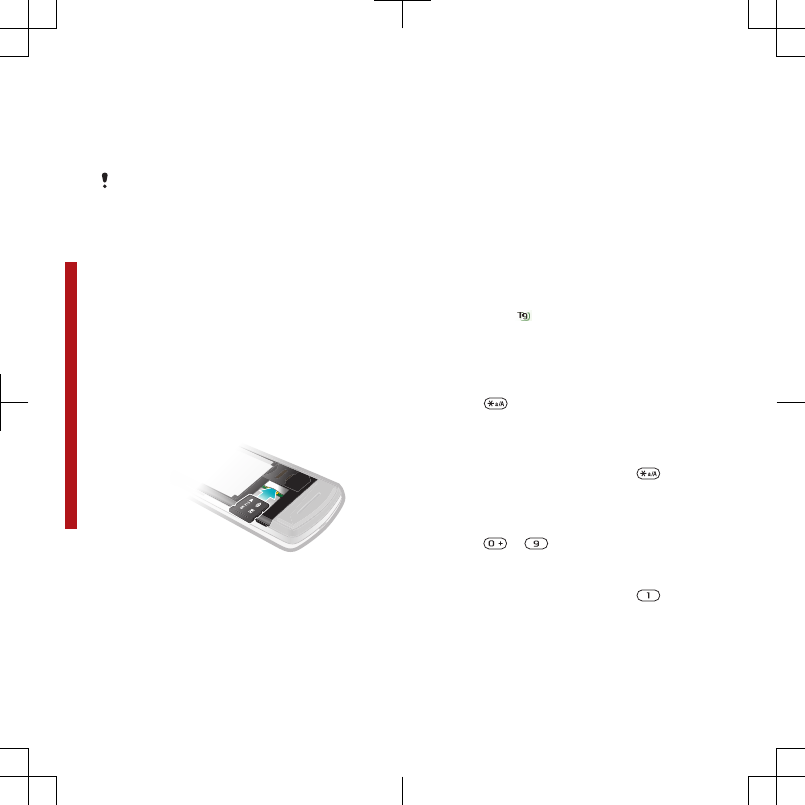
memory, but you can choose to save
them on the SIM card.
Memory card
You may have to purchase a memory card
separately.
Your phone supports Memory Stick
Micro™ (M2™) memory card adding
more storage space to your phone. It
can also be used as a portable memory
card with other compatible devices.
You can move content between the
memory card and the phone memory.
See Handling content in the phone on
page 23.
To insert a memory card
•Remove the battery cover and insert
the memory card with the gold-
coloured contacts facing down.
Phone language
You can select a language to use in
your phone.
To change the phone language
1Select Menu > Settings > General >
Language > Phone language.
2Select an option.
Entering text
You can use multitap text input or T9™
Text Input to enter text. The T9 Text
Input method uses a built-in dictionary.
To change text input method
•When you enter text, press and hold
down .
To shift between capitals and lower-
case letters
•When you enter text, press .
To enter numbers
•When you enter text, press and hold
down – .
To enter full stops and commas
•When you enter text, press .
To enter a symbol
1When you enter text, select Options >
Add symbol.
Getting started 15
This is a draft publication for internal use only.
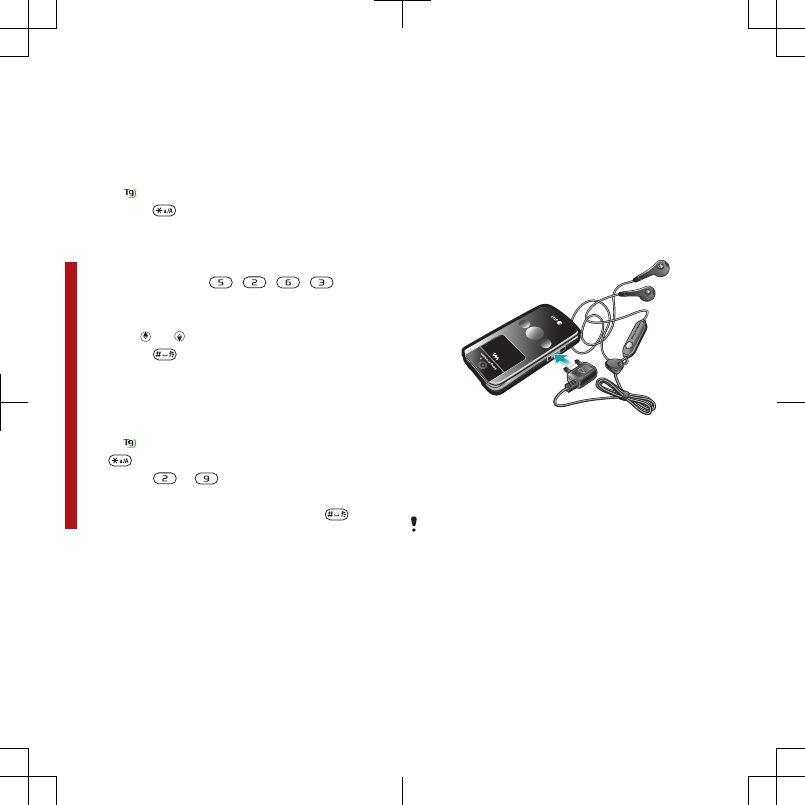
2Scroll to a symbol and select Insert.
To enter text using T9™ Text Input
1Select, for example, Menu >
Messaging > Write new > Message.
2If is not displayed, press and hold
down to change to T9 Text Input.
3Press each key only once, even if the
letter you want is not the first letter on
the key. For example, to write the word
“Jane”, press , , , . Write
the whole word before looking at the
suggestions.
4Use or to view suggestions.
5Press to accept a suggestion.
To enter text using multitap
1Select, for example, Menu >
Messaging > Write new > Message.
2If is displayed, press and hold down
to change to multitap text input.
3Press – repeatedly until the
desired letter appears.
4When a word is written, press to
add a space.
To add words to the built-in dictionary
1When you enter text using T9 Text
Input, select Options > Spell word.
2Write the word using multitap input and
select Insert.
Walkman™
You can listen to music, audio books
and podcasts. For more information,
see Transferring content to and from a
computer on page 26.
Stereo portable handsfree
To use a handsfree
•Connect a portable handsfree. Music
stops when you receive a call and
resumes when the call has ended.
If headphones are not included with the
phone, you may purchase them
separately.
16 Walkman™
This is a draft publication for internal use only.
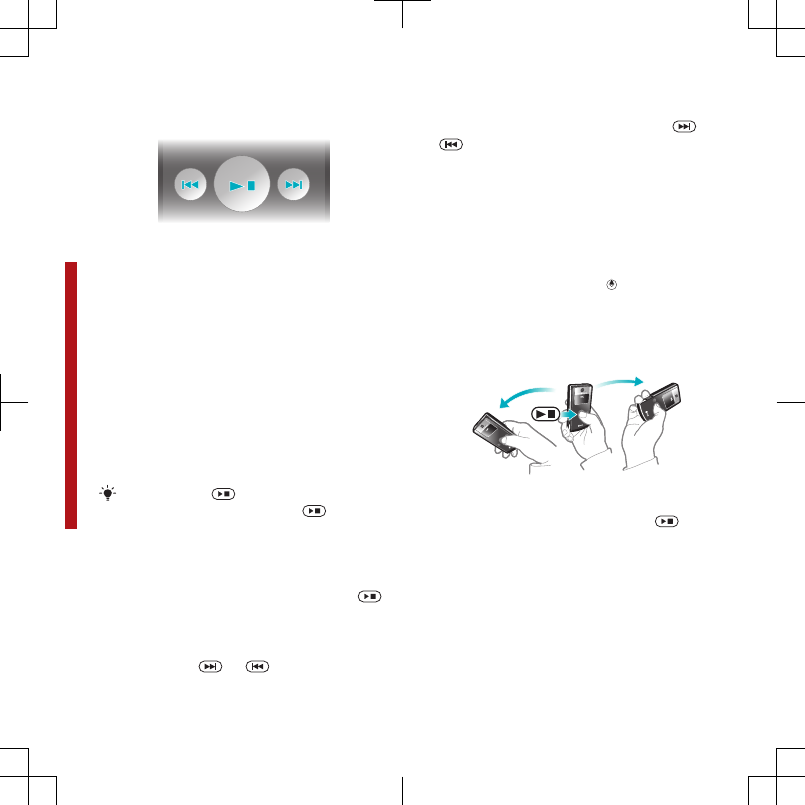
Walkman™ player
You can use the media player keys to
control the Walkman™ player when the
phone is closed. The keys must be
unlocked. For information on how to
unlock the keys, see To unlock the
media player keys on page 59.
To play music
1When the phone is open, select Menu
> AT&T Music > WALKMAN.
2Browse by category using the
navigation key.
3Scroll to a title and select Play.
You can use to start playing music
when the phone is closed. starts the
last used music application, that is the
Walkman™ player or the radio.
To stop playing music
•When the phone is closed, press .
To fast forward and rewind
•When the phone is closed, press and
hold down or .
To move between tracks
•When the phone is closed, press or
.
To minimise the player
•When the phone is open, select
Options > Minimise.
To return to the player
•When the phone is open and you are
not in any menu, press .
Shake control
To switch tracks
1When the phone is closed and music is
playing, press and hold down and
move the phone to the right with a flick
of your wrist to go to the next track.
2To go to the previous track, use the
same action to the left.
Walkman™ 17
This is a draft publication for internal use only.
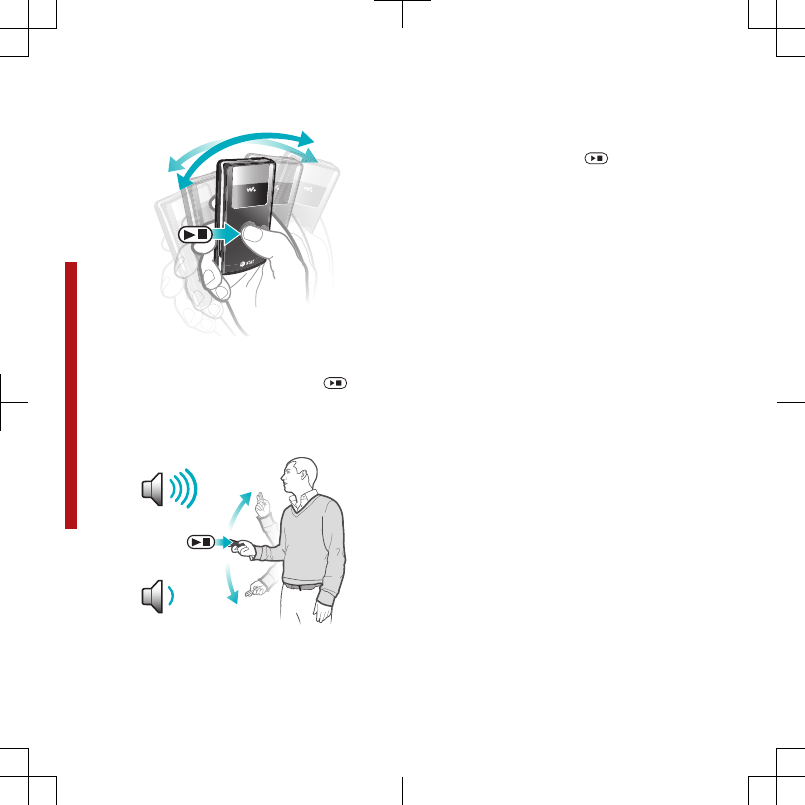
To shuffle tracks
•When the phone is closed and music is
playing, press and hold down and
shake your phone.
To change the volume
1When the phone is closed and music is
playing, hold the phone out in front of
you facing upwards.
2Press and hold down and bend
your arm upwards towards you to
increase the volume. To decrease the
volume, repeat the action in the
opposite direction.
Playlists
You can create playlists to organise
your music. You can add tracks and
folders to a playlist. It may take a few
minutes for the phone to create a
playlist.
To create a playlist
1Select Menu > AT&T Music >
WALKMAN > Playlists.
2Scroll to New playlist and select Add.
3Enter a name and select OK.
4For each track you want to add, scroll
to the track and select Mark.
5Select Add to add the marked tracks to
the playlist.
To add tracks to a playlist
1When the phone is open, select Menu
> AT&T Music > WALKMAN > Playlists.
2Select a playlist.
3Scroll to Add music and select Add.
4For each track you want to add, scroll
to the track and select Mark.
18 Walkman™
This is a draft publication for internal use only.
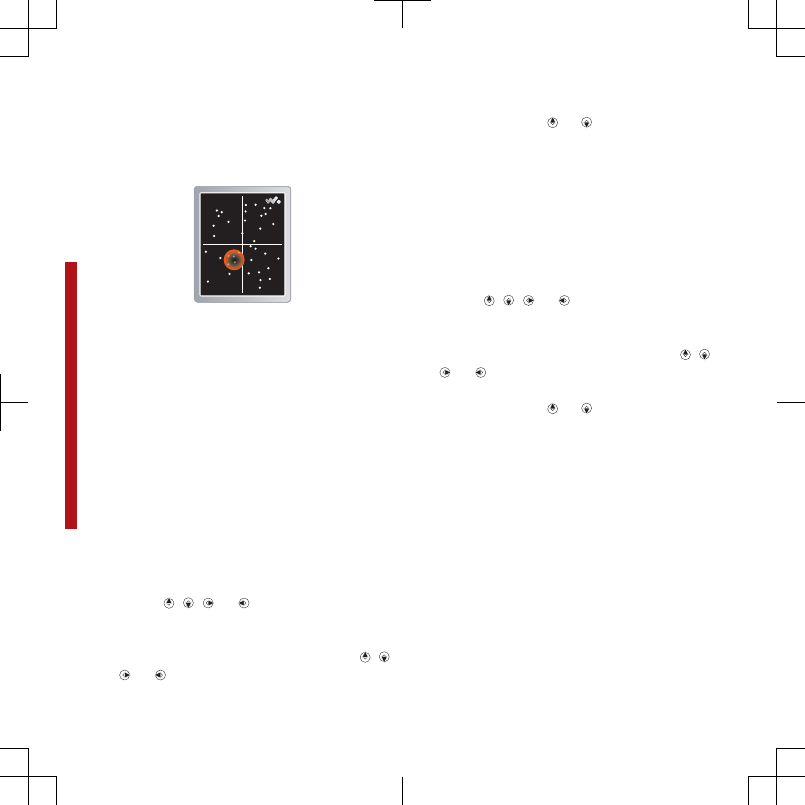
5Select Add to add the marked tracks to
the playlist.
SensMe™
With SensMe™ you can create
playlists in two ways, by mood or from
all the tracks in your phone. By mood,
you first use Media Go™ to transfer
tracks to your phone. Information such
as mood, tempo and chords is then
added. The tracks are displayed as
dots on a map with two axes. In the
All view, all the tracks in your phone are
placed randomly on the map.
To create a playlist by mood
1When the phone is open, select Menu
> Entertainment > Music.
2Scroll to SensMe™ and select Open.
3Press , , or .
4Make sure you are in Mood view. If you
are not, select Mood.
5To preview different tracks, press , ,
or .
6To choose an area of tracks, select
Add and press or .
7To create the playlist and play it in the
Walkman™ player, select Create.
8Select Options > Save playlist.
9Enter a name and select OK.
To create a playlist from All view
1When the phone is open, select Menu
> Entertainment > Music.
2Scroll to SensMe™ and select Open.
3Press , , or .
4Make sure you are in All view. If you are
not, select All.
5To preview different tracks, press , ,
or .
6To choose an area of tracks, select
Add and press or .
7To create the playlist and play it in the
Walkman™ player, select Create.
8Select Options > Save playlist.
9Enter a name and select OK.
Audio books
If you use Media Go™ to transfer audio
books to your phone from a computer,
you can listen to the audio books in
your phone. It may take a few minutes
before a transferred audio book
Walkman™ 19
This is a draft publication for internal use only.

appears in the list of available audio
books.
You can download the Media Go™
software from
www.sonyericsson.com/support
.
To access audio books
•Select Menu > AT&T Music >
WALKMAN > Audio books.
You can find audio books in formats
other than M4B and those that do not
have ID3v2 chapter tags in the Tracks
folder.
TrackID™ and MusicID™
TrackID™ and MusicID™ are music
recognition services. You can search
for title, artist and album name for a
track you hear playing on the radio in
your phone. TrackID can be used for
songs playing on the phone's built-in
FM Radio. MusicID can be used for
songs playing on an external music
source.
To search for track information
•When the built-in FM radio is playing
select Options > TrackID™.
•When an external music source is
playing, select Menu > AT&T Music >
MusicID™.
For best results, use TrackID™ and
MusicID™ in a quiet area.
Video player
To play videos
1Select Menu > Entertainment > Video >
Videos.
2Scroll to a title and select Play.
To stop playing videos
•Press the centre selection key.
To fast forward and rewind
•Press and hold down or .
To move between videos
•Press or .
To change the volume
•Press the side volume key up or down.
To change the video screen size
1Select Options > Video size.
2Select an option.
To save a picture from a video clip
1To pause the video clip, press the
centre selection key.
2To save the paused image as a picture,
select Options > Save picture.
20 Walkman™
This is a draft publication for internal use only.
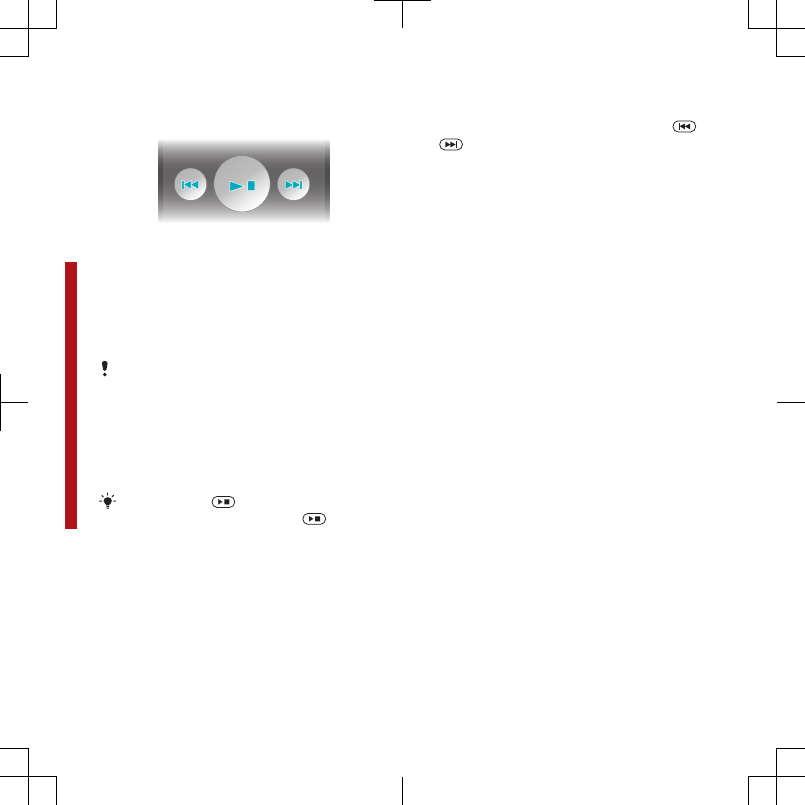
FM radio
You can use the media player keys to
control the radio when the phone is
closed. The keys must be unlocked.
For information on how to unlock the
keys, see To unlock the media player
keys on page 59.
Do not use your phone as a radio in places
where this is prohibited.
To turn on the FM radio
1Connect a handsfree to the phone.
2Select Menu > Tools & Apps > FM
Radio.
You can use to turn on the radio
when the phone is closed. starts the
last used music application, that is the
radio or the Walkman™ player.
To search for channels automatically
•When the phone is open, select
Search.
To search for channels manually
•When the phone is closed, press or
.
To change the volume
•Press the side volume key up or down.
To minimise the FM radio
•When the phone is open, select
Options > Minimise.
To return to the FM radio
•Select Menu > Tools & Apps > FM
Radio.
Saving channels
You can save up to 20 preset channels.
To save channels automatically
•When the phone is open, select
Options > Auto save.
To save channels manually
1When the phone is open and you have
found a radio channel, select Options >
Save.
2Scroll to a position and select Insert.
To select saved channels
1When the phone is open, select
Options > Channels.
2Select a radio channel.
Walkman™ 21
This is a draft publication for internal use only.
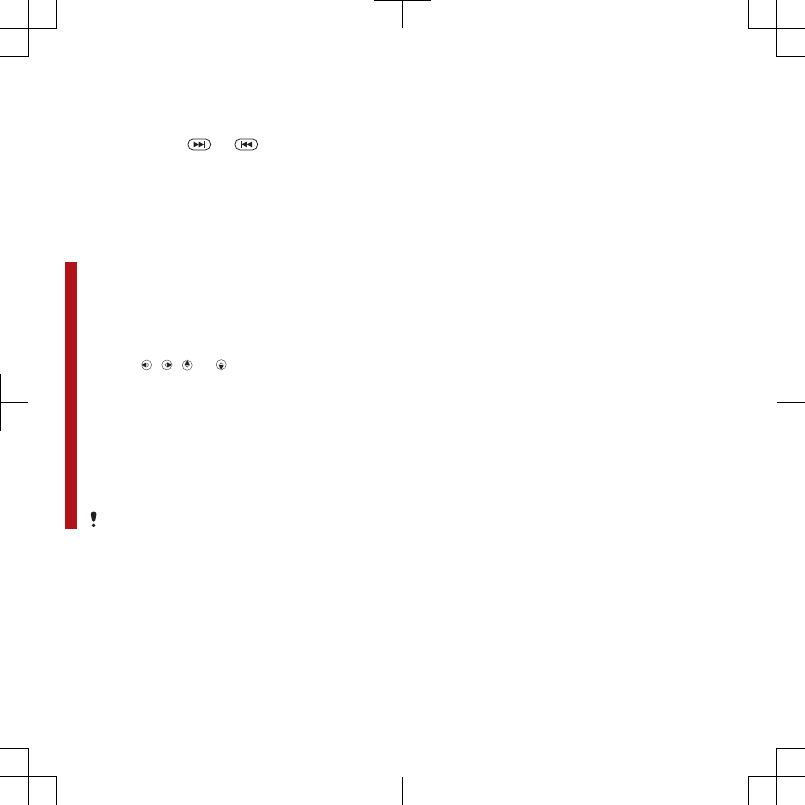
To switch between saved channels
•When the phone is closed, press and
hold down or .
MusicDJ™
You can compose and edit your own
melodies to use as ringtones. Pre-
arranged sounds with different
characteristics are available.
To compose a melody
1Select Menu > Tools & Apps > Tools
>MusicDJ™.
2Select to Insert, Copy or Paste sounds.
3Use , , or to scroll between the
sounds.
4Select Options > Save melody.
Record sound
You can record a voice memo or a call.
Recorded sounds can also be set as
ringtones.
In some countries or states it is required
by law that you inform the other person
before recording the call.
To record a sound
•Select Menu > Tools & Apps > Record
sound > Record.
To record a call
1During an ongoing call, select Options
> Record.
2To save the recording, select Save.
To listen to a recording
1Select Menu > Entertainment.
2Scroll to Music and select Open.
3Scroll to a recording and select Play.
AT&T Music
Go to AT&T Music to access your
Walkman player, purchase ringtones or
to access other music applications.
AT&T Music options
•WALKMAN – a music player.
•Shop Music – discover, sample and
download songs directly from your
mobile phone.
•MusicID – identify the song title, artist
or album in a flash by holding your
phone up to the music. MusicID can
identify millions of songs.
•XM Radio – XM Mobile Radio® offers
commercial-free music stations.
•Music Videos – stream your favorite
mobile videos straight to your phone.
•Make-UR-Tones – lets you create
custom ringtones from full track
songs.
22 Walkman™
This is a draft publication for internal use only.

•Community – access a hot user
community where you can chat with
your friends about the latest music.
•Music Apps – purchase music related
applications.
To access AT&T Music
•Select Menu > AT&T Music and select
an option.
Transferring and
handling content
You can transfer and handle content
such as pictures and music.
You are not allowed to exchange some
copyright-protected material. identifies
a protected item.
Handling content in the phone
You can use My Stuff to handle content
saved in the phone memory or on a
memory card. Tabs and icons in My
Stuff show where the content is saved.
If the memory is full, delete some
content to create space.
To view memory status
1Select Menu > My Stuff.
2Select Options > Memory status.
3Select Memory card or Phone.
To select more than one item in a
folder
1Select Menu > My Stuff.
2Scroll to a folder and select Open.
3Select Options > Mark > Mark several.
4For each item you want to mark, scroll
to the item and select Mark.
Transferring and handling content 23
This is a draft publication for internal use only.
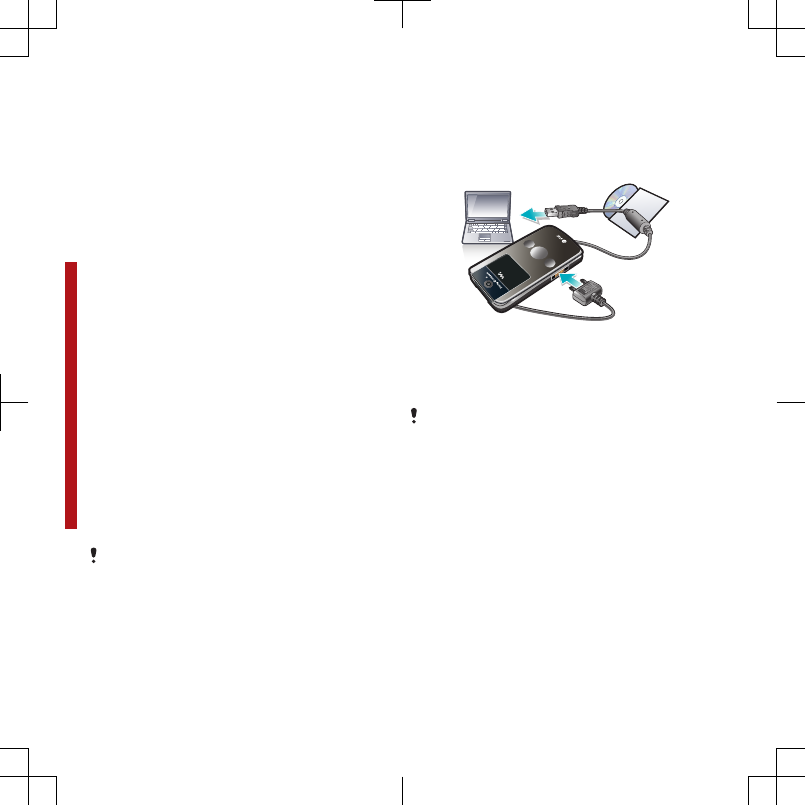
To move items between the phone
memory and the memory card
1Select Menu > My Stuff.
2Find an item and select Options >
Manage file > Move.
3Select Memory card or Phone.
4Scroll to a folder and select Open.
5Select Paste.
To view information about content
1Select Menu > My Stuff.
2Find an item and select Options >
Information.
Sending content to another
phone
You can send content, for example, in
messages or using Bluetooth™
wireless technology.
To send content
1Scroll to an item and select Options >
Send.
2Select a transfer method.
Make sure the receiving device supports
the transfer method you select.
Using the USB cable
You can connect your phone to a
computer with the USB cable to
synchronise, transfer and back up
phone content and use your phone as
a modem. For more information, go to
www.sonyericsson.com/support to
read Feature guides.
Before using a USB cable
See Required operating systems on
page 27.
Only use a USB cable supported by your
phone. Do not remove the USB cable
from your phone or computer during
transfer as this may corrupt the memory
card or the phone memory.
PC Software
You may use Windows® Explorer,
Sony Ericsson PC Suite, or Media Go™
with your phone. Sony Ericsson PC
software is available from
www.sonyericsson.com/support
to use
with your phone.
In the phone menu, you must select the
USB mode based on how you plan to
24 Transferring and handling content
This is a draft publication for internal use only.

use the USB cable with your phone.
The table lists the available computer applications and the corresponding
USB mode for each.
USB mode Purpose Computer application
Show menu Displays the USB menu when the USB
cable is attached to the phone. Any
Phone mode Synchronize the phone with a
computer. Sony Ericsson PC Suite
Media transfer Transfer music, pictures, or other files
between your phone and a computer.
The phone appears as a media device
on your computer. Sony Ericsson PC
Suite cannot access your phone in this
mode.
Microsoft® Windows®
Explorer
Print Print images from the Camera album.
Mass storage Transfer music, pictures or other files
between your phone and a computer.
The phone functions are turned off
automatically. All functions except
alarms and alerts are turned off in
Mass storage mode. The phone shuts
down, but restarts after removing the
cable.
Microsoft® Windows®
Explorer and Media Go™
USB default mode
You can select the USB mode the
phone uses when a USB cable is
attached.
To change the USB default mode
1Select Menu > Settings > the
Connectivity tab > USB > USB default
mode.
Transferring and handling content 25
This is a draft publication for internal use only.

2Select an option.
Disconnect the USB
The correct method for disconnecting
the USB cable depends on the USB
mode.
To disconnect the USB cable safely in
Mass storage or Phone mode
1When the phone is in Mass storage or
Phone mode, right-click the removable
disk icon in Windows Explorer.
2Select Eject.
3When the message is shown, Mass
storage session ended. It is now safe to
remove the USB cable..
To disconnect the USB cable safely in
Media transfer or Printer mode
•Remove the USB cable.
Transferring content to and
from a computer
With Windows® Explorer or Media
Go™, you can transfer music from
CDs, music on your computer, or music
that you have purchased online to a
memory card. Windows® Explorer is a
file manager that often comes with your
computer and can be used to view and
manage your files and folders. Media
Go™ enables you to transfer music,
photos and videos between your
phone and a computer. You can
download Media Go™ from
www.sonyericsson.com/support
. For
more information on using the phone
with a USB cable, see Using the USB
cable on page 24.
To use the phone with Windows®
Explorer
1Connect a USB cable to the phone and
the computer.
2On your phone (depending on the
phone setup):
•The phone may switch to Media
transfer and be ready to use.
•If prompted with a USB mode menu,
select Media transfer.
3On your computer:
•Wait until the memory card appears
as an external disk in Windows
Explorer.
•Drag and drop selected files
between the phone and the
computer.
•For full access to your music in the
music player, place it in the Music
folder on the phone’s memory or a
memory card. For more information
on how to move files already stored
on your phone or memory card to the
Music folder, see To move items
26 Transferring and handling content
This is a draft publication for internal use only.

between the phone memory and the
memory card on page 24.
Do not remove the USB cable from your
phone or computer during transfer, as this
may corrupt the memory card.
Required operating systems
You need one of these operating
systems to use Sony Ericsson PC
software:
•Microsoft® Windows Vista™
•Microsoft® Windows XP, Service
Pack 2 or higher
To download Media Go™
1Computer: In your Internet browser, go
to www.sonyericsson.com/support.
2Select a region and country.
3Select Software downloads.
4Select a phone from the list.
5Select Read more and download under
Media Go™.
6Select Download now and save the file
to your computer.
Remember where you save the file.
To install Media Go™ from the
downloaded file
1Locate the downloaded Media Go™
file on the computer.
2Double-click the file and follow the
instructions.
To transfer content using Media Go™
Do not remove the USB cable from your
phone or computer during transfer, as this
may corrupt the memory card or the
phone memory.
1Connect the phone to a computer with
a USB cable supported by your phone.
2On your phone (depending on setup):
•The phone may switch to Media
transfer. If so, disconnect the cable
and change the USB default mode to
Mass storage. See USB default mode
on page 25. Do not remove the USB
cable from your phone or computer
during transfer, as this may corrupt
the memory card. Media Go™
software is available for download at
www.sonyericsson.com/support.
•If prompted with a USB mode menu,
select Mass storage. The phone will
shut down in this mode but will
restart again when it is disconnected
from the USB cable.
3On your computer: Drag and drop
selected files between the phone and
the computer.
4Wait until the phone appears in Media
Go™.
Transferring and handling content 27
This is a draft publication for internal use only.

5Move files between your phone and the
computer in Media Go™.
Phone name
You can enter a name for your phone
that is shown to other devices when
using, for example, Bluetooth™
wireless technology.
To enter a phone name
1Select Menu > Settings > Connectivity >
Phone name.
2Enter the phone name and select OK.
Using Bluetooth™ wireless
technology
The Bluetooth™ function is free of
charge and makes wireless connection
to other Bluetooth devices possible.
You can, for example:
•Connect to handsfree devices.
•Connect to several devices at the
same time.
•Connect to computers and access
the Internet.
•Exchange items.
•Play multiplayer games.
A range within 10 metres (33 feet), with no
solid objects in between, is
recommended for Bluetooth
communication.
Before using Bluetooth wireless
technology
You must turn on the Bluetooth
function to communicate with other
devices. You may also have to pair your
phone with other Bluetooth devices.
To turn on the Bluetooth function
•Select Menu > Settings > Connectivity >
Bluetooth > Turn on.
Make sure that the device you want to pair
your phone with has the Bluetooth
function activated and Bluetooth visibility
turned on.
To pair the phone with a device
1Select Menu > Settings > Connectivity >
Bluetooth > My devices.
2Scroll to New device and select Add to
search for available devices.
3Select a device.
4Enter a passcode, if required.
To allow connection to the phone
1Select Menu > Settings > Connectivity >
Bluetooth > My devices.
2Select a device from the list.
3Select Options > Allow connection.
4Select Always ask or Always allow.
This is only possible with devices that
require access to a secure service.
28 Transferring and handling content
This is a draft publication for internal use only.

To pair the phone with a Bluetooth
handsfree for the first time
1Select Menu > Settings > Connectivity >
Bluetooth > Handsfree.
2Select a device.
3Enter a passcode, if required.
Power saving
You can save battery power with the
Power save function. In Power save
mode you can only connect with a
single Bluetooth device. If you want to
connect with more than one Bluetooth
device at the same time you must turn
this function off.
To turn on power save
•Select Menu > Settings > Connectivity >
Bluetooth > Power save > On.
Transferring sound to and from a
Bluetooth handsfree
You can transfer the sound to and from
a Bluetooth handsfree using a phone
key or the handsfree key.
To transfer sound
1Select Menu > Settings > Connectivity >
Bluetooth > Handsfree > Incoming call.
2Select an option. In phone transfers
sound to the phone. In handsfree
transfers sound to the handsfree.
You need to answer the call with the
phone key for this setting to apply.
To transfer sound during a call
1During a call, select Sound.
2Select from the list.
Backing up and restoring
You can backup and restore contacts,
the calendar, tasks, notes and
bookmarks using the Sony Ericsson PC
Suite.
You can backup and restore Address
Book contacts, the calendar, tasks,
notes and bookmarks using the
Sony Ericsson PC Suite.
Before backing up and restoring, you
need to install the Sony Ericsson PC
Suite, which is available from
www.sonyericsson/support.
You can backup and restore contacts
within your phone using a Memory
Stick Micro™ (M2™) memory card.
You can move content between the
memory card and the phone memory.
See Handling content in the phone on
page 23.
Back up your phone content regularly to
make sure you do not lose it.
Transferring and handling content 29
This is a draft publication for internal use only.
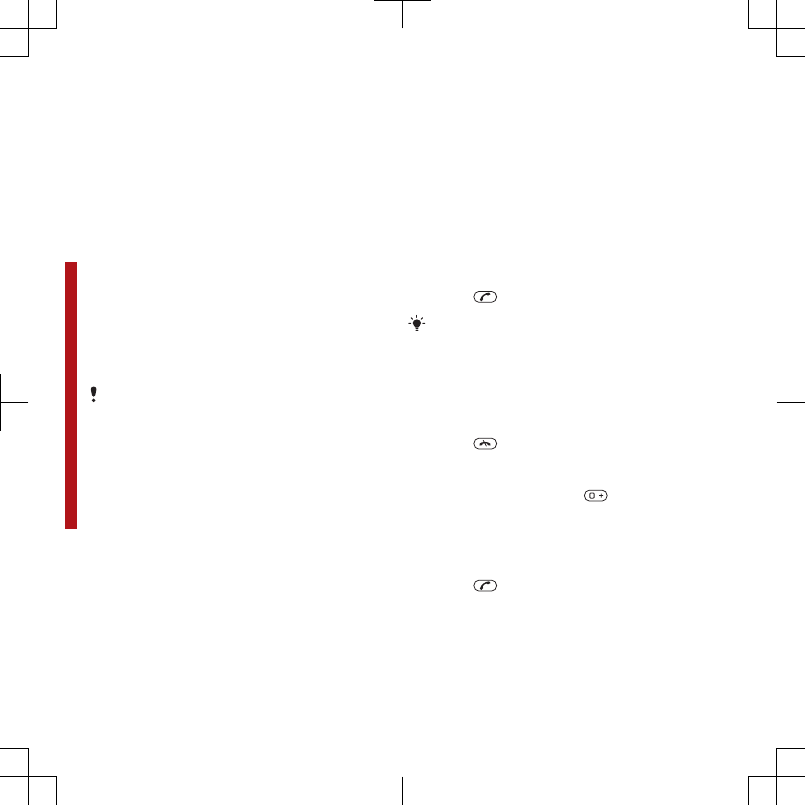
To make a backup using the
Sony Ericsson PC Suite
1Computer: Start the Sony Ericsson PC
Suite from Start/Programs/
Sony Ericsson/Sony Ericsson PC
Suite.
2Follow the instructions in the
Sony Ericsson PC Suite for how to
connect.
3Phone: Select Phone mode.
4Computer: Go to the backup and
restore section in the Sony Ericsson PC
Suite and make a backup.
To restore phone content using the
Sony Ericsson PC Suite
The Sony Ericsson PC Suite will overwrite
all the phone content during the restore
process. You may damage your phone if
you interrupt the process.
1Computer: Start the Sony Ericsson PC
Suite from Start/Programs/
Sony Ericsson/Sony Ericsson PC
Suite.
2Follow the instructions in the
Sony Ericsson PC Suite for how to
connect.
3Phone: Select Phone mode.
4Computer: Go to the backup and
restore section in the Sony Ericsson PC
Suite and restore your phone.
Calling
Making and receiving calls
You need to turn on your phone and be
within range of a network.
To make a call
1Enter a phone number (with
international country code and area
code, if applicable).
2Press .
You can call numbers from your Address
Book and call list. See Address Book on
page 32, and Call list on page 32. You
can also use your voice to make calls.
See Voice control on page 36.
To end a call
•Press .
To make international calls
1Press and hold down until a “+”
sign appears.
2Enter the country code, area code
(without the first zero) and phone
number.
3Press .
30 Calling
This is a draft publication for internal use only.
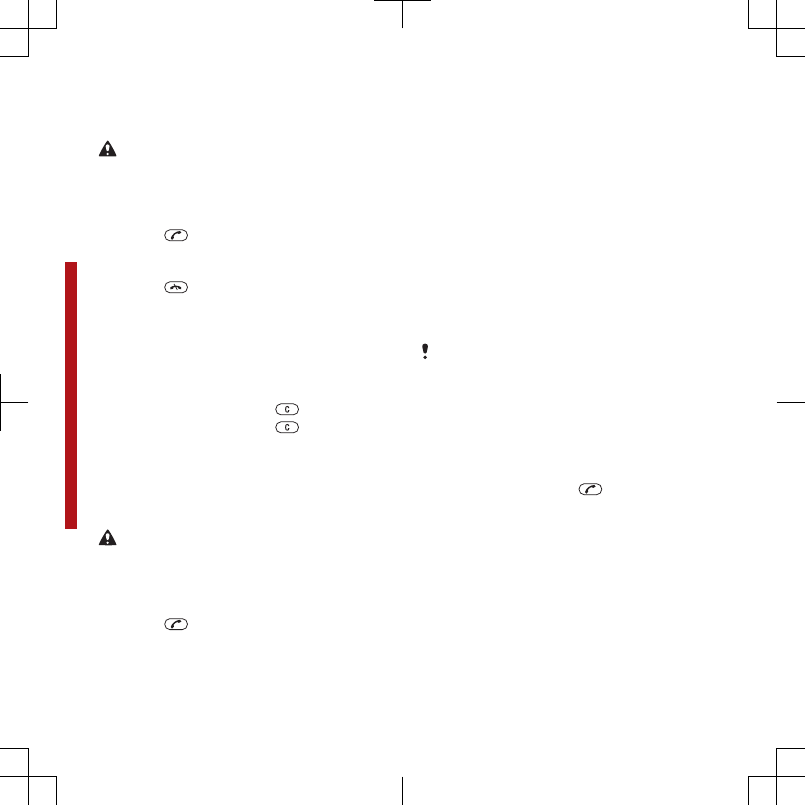
To re-dial a number
•When Retry? appears select Yes.
Do not hold your phone to your ear when
waiting. When the call connects, your
phone gives a loud signal.
To answer a call
•Press .
To reject a call
•Press .
To change the ear speaker volume
during a call
•Press the volume key up or down.
To mute the microphone during a call
1Press and hold down .
2Press and hold down again to
resume.
To turn on the loudspeaker during a
call
•Press SpkrOn.
Do not hold your phone to your ear when
using the loudspeaker. This could
damage your hearing.
To view missed calls
•Press to open the call list.
Networks
Your phone switches automatically
between GSM and 3G (UMTS)
networks depending on availability.
Emergency calls
Your phone supports international
emergency numbers, for example, 112
or 911. You can normally use these
numbers to make emergency calls in
any country, with or without the SIM
card inserted, if you are within range of
a network.
In some countries, other emergency
numbers may also be promoted. Your
network operator may therefore have
saved additional local emergency
numbers on the SIM card.
To make an emergency call
•Enter 112 (the international emergency
number) and press .
To view your local emergency
numbers
1Select Menu > Address Book.
2Scroll to New contact and select
Options > Special numbers >
Emergency nos..
Calling 31
This is a draft publication for internal use only.
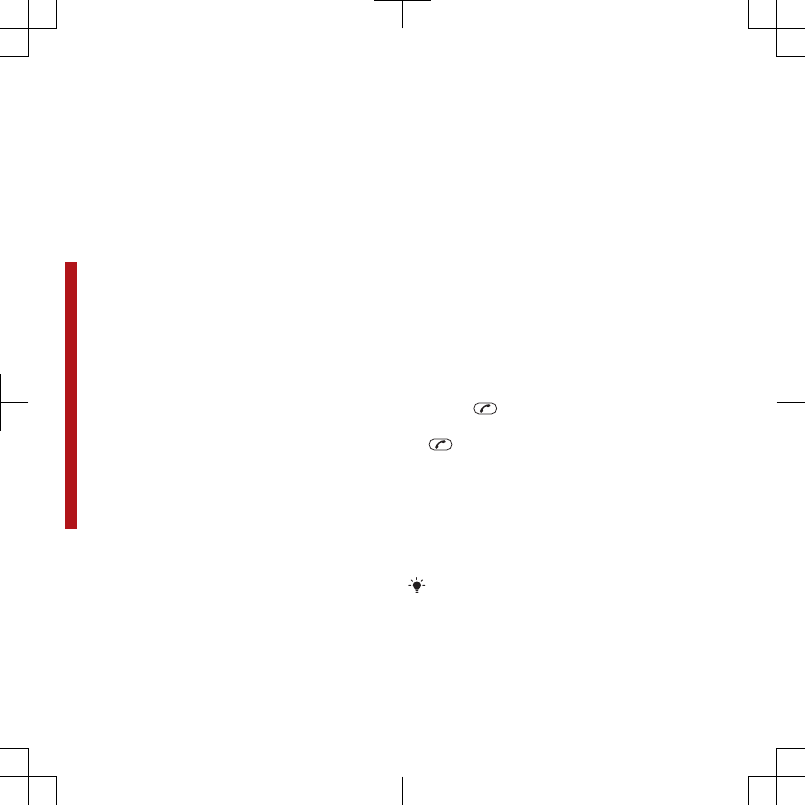
AT&T Video Share
You can share experiences while on a
call with friends and family when they
happen or save them to share later.
When on a call, the person who initiates
the Video Share session transmits the
video. Only the person placing a Video
Share call can save the Video Share
session.
Types of Video Share calls
You can share information live or a pre-
recorded session.
•Live share – streams live information
as the camera captures it.
•Pre-recorded – allows you to share a
previously recorded Video Share
session.
Before you begin
To use Video Share service, both
parties on the call must have:
•Video share service activated on
their account.
•3G coverage.
•Video Share turned on.
To initiate a Video Share session
•While on a call, select Vid. Share.
To accept a Video Share session
•When you receive a Video Share call
request, press Yes.
To end a Video Share session
•To continue the call, but end the Video
Share session, press Stop.
To save Video Share sessions
•Select Menu > Settings > the Calls tab
> Video Share > Auto record.
Call list
You can view information about recent
calls.
To call a number from the call list
1Press and scroll to a tab.
2Scroll to a name or a number and press
.
Address Book
You can save names, phone numbers
and personal information in Address
Book. Information can be saved in the
phone memory or on the SIM card.
You can synchronise your contacts using
the Sony Ericsson PC Suite.
Default contacts
You can choose which contact
information is shown as default. If
32 Calling
This is a draft publication for internal use only.
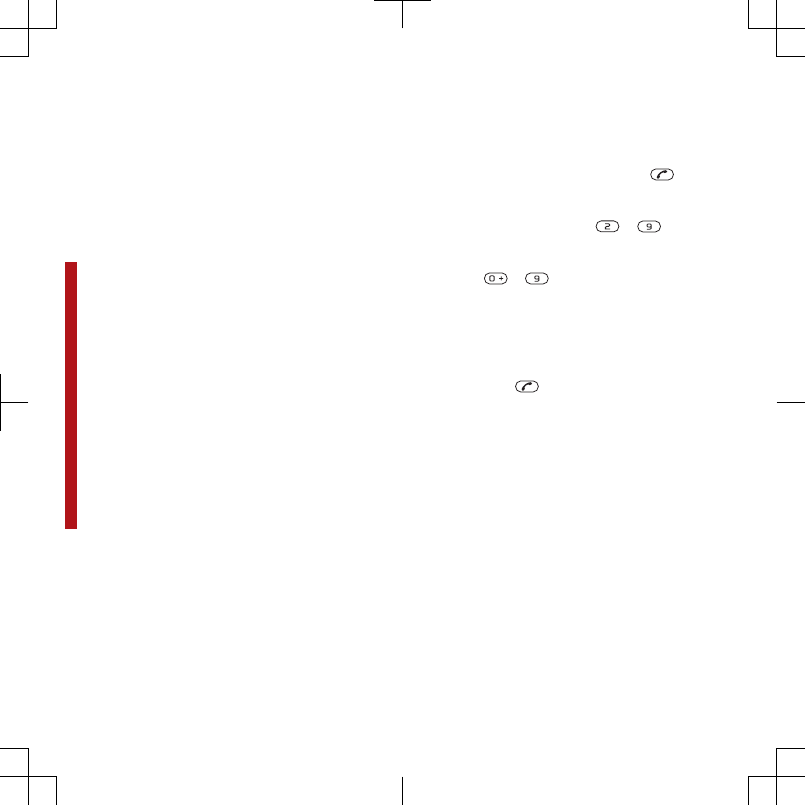
Phone contacts is selected as default,
your contacts show all the information
saved in Address Book. If you select
SIM contacts as default, your contacts
show names and numbers saved on
the SIM card.
To select default contacts
1Select Menu > Address Book.
2Scroll to New contact and select
Options > Advanced > Default contacts.
3Select an option.
Phone contacts
Phone contacts can contain names,
phone numbers and personal
information. They are saved in the
phone memory.
To add a phone contact
1Select Menu > Address Book.
2Scroll to New contact and select Add.
3Enter the name and select OK.
4Scroll to New number: and select Add.
5Enter the number and select OK.
6Select a number option.
7Scroll between the tabs and add
information to the fields.
8Select Save.
Calling contacts
To call a contact
1Select Menu > Address Book.
2Scroll to a contact and press .
To go directly to the contacts list
•Press and hold down – .
To call with Smart search
1Press – to enter a sequence of
(at least two) digits. All entries which
match the sequence of digits or
corresponding letters are shown in a
list.
2Scroll to a contact or a phone number
and press .
To turn on or off Smart search
1Select Menu > Settings > Calls > Smart
search.
2Select an option.
Editing contacts
To add information to a phone
contact
1Select Menu > Address Book.
2Scroll to a contact and select Options >
Edit contact.
3Scroll between the tabs and select
Add or Edit.
Calling 33
This is a draft publication for internal use only.

4Select an option and an item to add or
edit.
5Select Save.
If your subscription supports Calling Line
Identification (CLI) service, you can
assign personal ringtones and pictures to
contacts.
To copy names and numbers to
phone contacts
1Select Menu > Address Book.
2Scroll to New contact and select
Options > Advanced > Copy from SIM.
3Select an option.
To copy names and numbers to the
SIM card
1Select Menu > Address Book.
2Scroll to New contact and select
Options > Advanced > Copy to SIM.
3Select an option.
When you copy all contacts from your
phone to the SIM card, all existing SIM
card information is replaced.
To automatically save names and
phone numbers on the SIM card
1Select Menu > Address Book.
2Scroll to New contact and select
Options > Advanced > Auto save on
SIM.
3Select an option.
To save contacts on a memory card
1Select Menu > Address Book.
2Scroll to New contact and select
Options > Advanced > Back up to m.
card.
SIM contacts
SIM contacts can contain names and
numbers only. They are saved on the
SIM card.
To add a SIM contact
1Select Menu > Address Book.
2Scroll to New contact and select Add.
3Enter the name and select OK.
4Enter the number and select OK.
5Select a number option and add more
information, if available.
6Select Save.
Deleting contacts
To delete all contacts
1Select Menu > Address Book.
2Scroll to New contact and select
Options > Advanced > Delete all
contacts.
3Select an option.
Contact memory status
The number of contacts you can save
in your phone or on the SIM card
depends on available memory.
34 Calling
This is a draft publication for internal use only.

To view contact memory status
1Select Menu > Address Book.
2Scroll to New contact and select
Options > Advanced > Memory status.
Myself
You can enter information about
yourself and, for example, send your
business card.
To enter Myself information
1Select Menu > Address Book.
2Scroll to Myself and select Open.
3Scroll to an option and edit the
information.
4Select Save.
To add your own business card
1Select Menu > Address Book.
2Scroll to Myself and select Open.
3Scroll to My contact info and select
Add > Create new.
4Scroll between the tabs and add
information to the fields.
5Enter the information and select Save.
Groups
You can create a group of phone
numbers and email addresses from
Phone contacts to send messages to.
See Messaging on page 39. You can
also use groups (with phone numbers)
when you create accepted callers lists.
See Accept calls on page 38.
To create a group of numbers and
email addresses
1Select Menu > Address Book.
2Scroll to New contact and select
Options > Groups.
3Scroll to New group and select Add.
4Enter a name for the group and select
Continue.
5Scroll to New and select Add.
6For each contact phone number or
email address you want to mark, scroll
to it and select Mark.
7Select Continue > Done.
Speed dial
Speed dialling lets you select nine
contacts that you can dial quickly from
standby. The contacts can be saved in
positions 1-9.
To add contacts to speed dial
numbers
1Select Menu > Address Book.
2Scroll to New contact and select
Options > Speed dial.
3Scroll to a position number and select
Add.
4Select a contact.
Calling 35
This is a draft publication for internal use only.
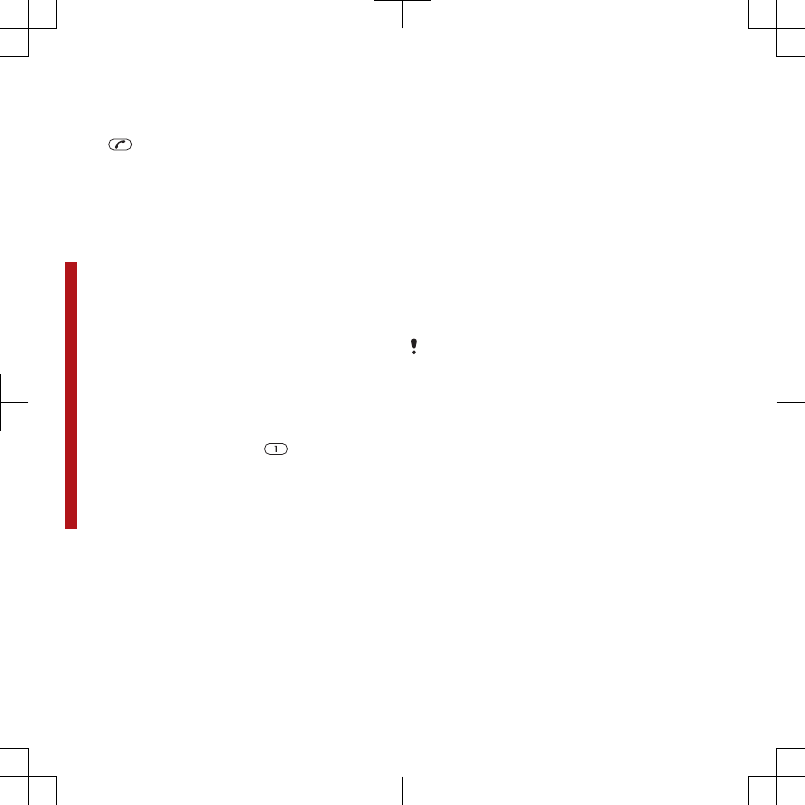
To speed dial
•Enter the position number and press
.
More calling features
Voicemail
If your subscription includes an
answering service, callers can leave a
voicemail message when you cannot
answer a call.
To enter your voicemail number
1Select Menu > Messaging > Settings >
the Message settings tab > Voicemail
number.
2Enter the number and select OK.
To call your voicemail service
•Press and hold down .
Voice control
By creating voice commands you can:
•Voice dial – call someone by saying
their name
•Answer and reject calls when you
use a handsfree
To record a voice command using
voice dialling
1Select Menu > Settings > General >
Voice control > Voice dialling > Activate.
2Select Yes > New voice command and
select a contact. If the contact has
more than one number, select the
number to add the voice command to.
3Record a voice command such as
“John mobile.”
4Follow the instructions that appear.
Wait for the tone and say the command
to record. The voice command is
played back to you.
5If the recording sounds OK, select Yes.
If not, select No and repeat steps 3 and
4.
Voice commands are saved in the phone
memory only. They cannot be used in
another phone.
To voice dial
1Press and hold down a volume key.
2Wait for the tone and say a recorded
name, for example “John mobile.” The
phone plays the name back to you and
connects the call.
Diverting calls
You can divert calls, for example, to an
answering service.
To divert calls
1Select Menu > Settings > Calls > Divert
calls.
2Select a call type and a divert option.
36 Calling
This is a draft publication for internal use only.
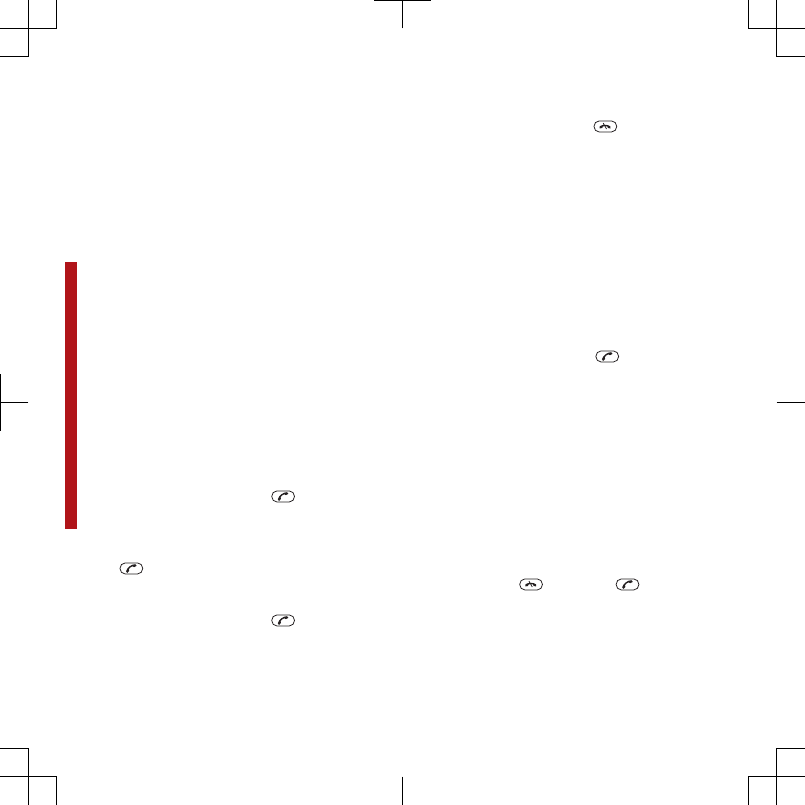
3Select Activate.
4Enter the number to divert calls to and
select OK.
More than one call
You can handle more than one call at a
time. For example, you can put an
ongoing call on hold, while you make or
answer a second call. You can also
switch between the two calls. You
cannot answer a third call without
ending one of the first two calls.
Call waiting
You will hear a beep if you receive a
second call while call waiting is active.
To activate call waiting
•Select Menu > Settings > Calls >
Manage calls > Call waiting > Activate.
To make a second call
1During the call, press . This puts the
ongoing call on hold.
2Select Options > Add call.
3Enter the number to call and press
.
To answer a second call
•During the call, press . This puts the
ongoing call on hold.
To reject a second call
•During the call, press and continue
with the ongoing call.
To end an ongoing call and answer a
second call
•During the call, select Replace active
call.
Handling two voice calls
You can have calls ongoing and on
hold at the same time.
To switch between two calls
•During the call, press .
To join two calls
•During the call, select Options > Join
calls.
To connect two calls
•During the call, select Options >
Transfer call. You are disconnected
from both calls.
To end an ongoing call and return to
the call on hold
•First press and then .
Conference calls
With a conference call, you can have a
joint conversation with up to five
people.
Calling 37
This is a draft publication for internal use only.
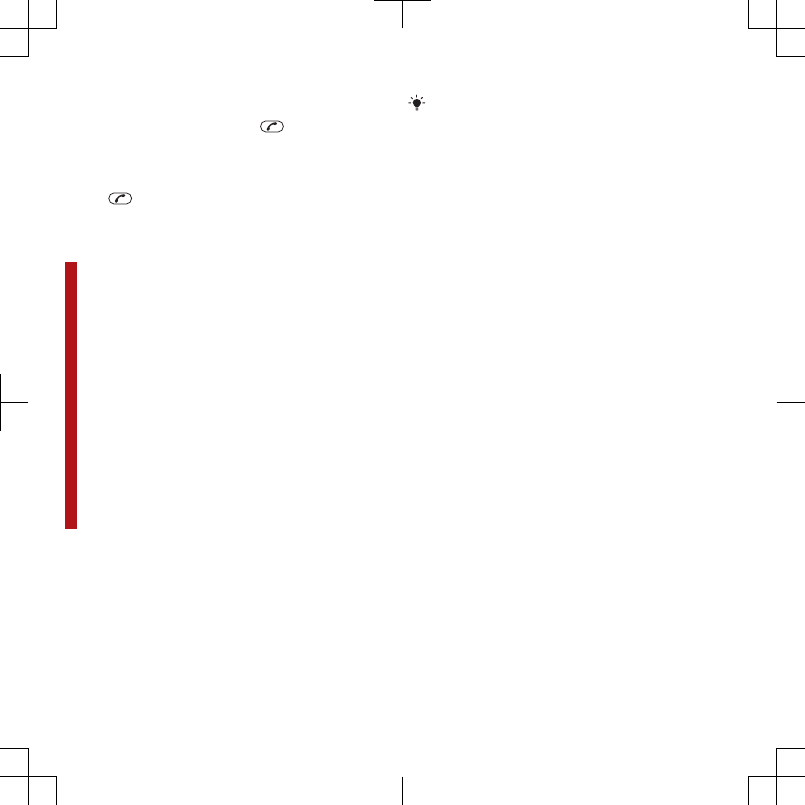
To add a new participant
1During the call, press . This puts the
joined calls on hold.
2Select Options > Add call.
3Enter the number to call and press
.
4Select Options > Join calls to add the
new participant.
5Repeat this task to add more
participants.
To release a participant
1Select Options > Release party.
2Select the participant to release.
To have a private conversation
1During the call, select Options > Talk
to and select the participant to talk to.
2To resume the conference call, select
Options > Join calls.
Accept calls
You can choose to receive calls from
certain phone numbers only.
To add numbers to the accepted
callers list
1Select Menu > Settings > Calls >
Manage calls > Accept calls > Only from
list.
2Scroll to New and select Add.
3Select a contact or Groups.
See Groups on page 35.
To accept all calls
•Select Menu > Settings > Calls >
Manage calls > Accept calls > All
callers.
Showing or hiding your phone number
You can decide to show or hide your
phone number when you make a call.
To hide your phone number
1Select Menu > Settings > Recent Calls >
Show/hide my no..
2Select Hide number.
38 Calling
This is a draft publication for internal use only.

Messaging
Text and multimedia
messages
Messages can contain text, pictures,
sound effects, animations, and
melodies. You can also create and use
templates for your messages.
When sending messages, the phone
automatically selects the most suitable
method (as a text or multimedia
message) for sending the message.
Sending messages
You can send messages from your
phone. The maximum size of a
standard text message is 160
characters including spaces if no other
items are added to the message. If you
enter more than 160 characters, a
second message is created. Your
messages are sent as one
concatenated message.
To create and send a message
1Select Menu > Messaging > Write new
> Message.
2Enter text. To add items to the
message, press , scroll and select
an item.
3Select Continue > Addr. Book look-up.
4Select a recipient and select Send.
If you send a message to a group, you
will be charged for each member.
To copy and paste text in a message
1When you write the message, select
Options > Copy & paste.
2Select Copy all or Mark & copy. Scroll to
and mark text in the message.
3Select Options > Copy & paste > Paste.
Receiving and saving messages
You are notified when you receive a
message. Messages are automatically
saved in the phone memory. When the
phone memory is full, you can delete
messages or save them on a memory
card or on the SIM card.
To save an incoming message on a
memory card
•Select Menu > Messaging > Settings >
the Message settings tab > Save to >
Memory card.
To save a message on the SIM card
1Select Menu > Messaging > Messages
and select a folder.
2Scroll to a message and select
Options > Save message.
To view a message from the inbox
1Select Menu > Messaging > Inbox.
Messaging 39
This is a draft publication for internal use only.

2Scroll to the message and select View.
To call a number in a message
•When you view the message, scroll to
the phone number and press .
Templates
If you often use the same phrases and
pictures in a message, you can save
the message as a template.
To add a message template
1Select Menu > Messaging > Templates
> New template > Add.
2Enter text. To add items to the
message, press , scroll and select
an item.
3Select Save.
4Enter a title and select OK.
To save a message as a template
1Select Menu > Messaging > Inbox.
2Scroll to the message and select View
> Options > Save as template.
Message options
You can set some options, such as the
Message alert and default storage
location, to apply to all messages. You
can set other options, such as the
Delivery priority and Delivery time, for
each message you send.
To set options for all messages
1Select Menu > Messaging > the
Message settings tab.
2Select an option.
To set options for a specific message
1When the message is ready and a
recipient is selected, select Options >
Advanced.
2Scroll to an option and select Edit.
Conversations
You can choose whether to view your
messages in Conversations or Inbox. A
messaging conversation shows all
messaging communication between
you and one of your contacts.
To view messages in Conversations
1Select Menu > Messaging > Inbox > the
Conversations tab.
2Select a conversation.
To send a message from
Conversations
1Select Menu > Messaging >
Conversations.
2Select a conversation.
3Write a message and select Send.
40 Messaging
This is a draft publication for internal use only.

Voice messages
You can send and receive a sound
recording as a voice message.
The sender and recipient must have a
subscription supporting picture
messaging.
To record and send a voice message
1Select Menu > Messaging > Write new
> Voice message.
2Record the message and select Stop >
Send > Addr. Book look-up.
3Select a recipient and select Send.
Mobile Email
Check your email accounts, such as
Yahoo!™ Mail, AT&T Yahoo!™,
Windows™ Live Mail, AOL™ and
AIM™ quickly and easily.
Before using Mobile Email
•Verify that your AT&T account
supports a data plan.
•Have your email account information
ready.
To use Mobile Email
1Select Menu > Messaging > Mobile
Email.
2Select the provider you want to use.
Follow the prompts to enter your
username and password.
3Select Next to log into your account.
To write a new email
1From your Mobile Email inbox, select
Options > Compose New.
2Fill in each field.
3Press Send.
To delete an email
1From your Mobile Email inbox, select
an email.
2Select Options > Delete.
Menu names may change with different
email providers.
To view message options
1From your Mobile Email inbox, select
an email.
2Select Options and scroll to an option.
Menu names may change with different
email providers.
Instant Messaging (IM)
Connect and log into the IM server to
communicate online with your family
and friends. If your subscription
supports instant messaging and
presence services, you can send and
Messaging 41
This is a draft publication for internal use only.

receive messages and see contact
status when they are online.
To choose your IM settings
1Select Menu > Messaging > IM.
2Select IM community > Sign In.
3Enter your account name and
password to configure the account.
4Select Sign In.
After signing into an IM community, its
name replaces IM in the menu.
To use IM
1Select Menu > Messaging .
2Select your IM community > Sign In.
3Enter your password, if needed.
4Press Sign In.
To add a contact to the list
1Select Menu > Messaging.
2Select your IM community >Sign In.
3Enter your password, if needed.
4Press Sign In.
5Select the Buddies tab > Options > Add
buddy.
6Enter the contact’s screen name.
The tab name varies depending on IM
community chosen.
To send an IM
1Select Menu > Messaging.
2Select your IM community >Sign In.
3Enter your password, if needed.
4Press Sign In.
5Select your IM community > the
Buddies tab.
6Select a buddy > Send IM.
7Type your message and select Send.
Status
Show your status to your contacts only
or show it to all users on the IM server.
To set the status
1Select Menu > Messaging.
2Select your IM community > My status
tab.
3Choose Available and select Edit.
4Select an option.
Save password
Prior to logging in, you can store the
password for your community to avoid
entering it at each sign on.
To save the password
1Select Menu > Messaging.
2Select your IM community >Sign In.
3Select Save password:.
Auto Sign in
You can bypass the sign in screen
when logging in to your IM community
by turning on the phone.
42 Messaging
This is a draft publication for internal use only.
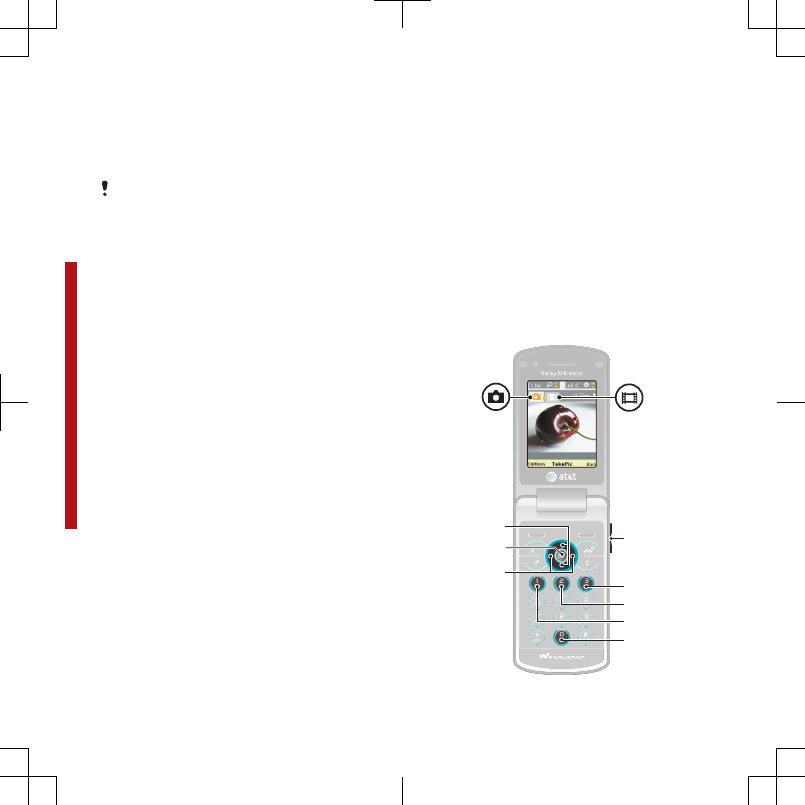
To automatically sign in
1Verify Save password: is on.
2Select Menu > Messaging.
3Select your IM community >Sign In.
See Save password on page 42.
Imaging
You can take photos and record video
clips to view, save or send. You find
saved photos and video clips in
Entertainment and in My Stuff.
Using the camera
To activate the camera
•Select Menu > Camera.
Viewfinder and camera keys
2
3
6
7
8
1
4
5
Imaging 43
This is a draft publication for internal use only.

1 Zoom in or out
2 Take photos/Record video
3 Select still camera or video camera
4 Brightness
5Self-timer
6Night mode
7 Camera: Shoot mode
Video: Video length
8 Camera key guide
To take a photo
1Activate the camera and press the
navigation key to scroll to .
2Press the centre selection key to take a
photo. The photo is automatically
saved.
To record a video clip
1Activate the camera and press the
navigation key to scroll to .
2Press the centre selection key to start
recording.
3To stop recording, press the centre
selection key. The video clip is
automatically saved.
To use zoom
•Press or .
When taking a photo, zoom is available
only in VGA picture size.
To adjust brightness
•Press the volume key up or down.
To view photos
1Activate the camera and press the
navigation key to scroll to .
2Select Options > View all photos
3Press or to scroll to a photo.
To view video clips
1Activate the camera and press the
navigation key to scroll to .
2Select Options > View all clips.
3Scroll to a video clip and press the
centre selection key.
More camera features
To change settings
•Activate the camera and select
Options.
To view information about settings
•Scroll to a setting and select Info.
Photo fix
You can use Photo fix to improve
photos. In a one-click operation,
44 Imaging
This is a draft publication for internal use only.

brightness, light and contrast are
adjusted to give you the best possible
photo. The improvements are saved as
a copy of the photo. The original photo
is not affected.
To improve a photo with Photo fix
1Activate the camera and press the
navigation key to scroll to .
2Make sure Review is set to On. Select
Options > Review > On.
3Take a photo.
4During review, select Options > Photo
fix.
Camera tips and tricks
Rule of thirds
Don’t place your subject in the middle
of the frame. By placing it a third of the
way in, you will achieve a better result.
Hold it steady
Avoid blurry pictures by holding the
camera steady. Try to steady your hand
by leaning it against a solid object.
Get closer
By getting as close as possible to your
subject you won’t have to rely on the
zoom. Try to fill your viewfinder with
your subject.
Stay within the flash range
Pictures taken beyond the maximum
flash range will be too dark. The
maximum flash range is about four
steps away.
Consider variety
Think different angles, move towards
the object. Take some vertical pictures.
Try different positions.
Use a plain background
A plain background will help to
highlight your subject.
Keep your lens clean
Phones are used in all manner of
weather and places and carried in
pockets and bags. This results in the
camera lens becoming dirty and
covered with fingerprints. Use a soft
cloth to clean the lens.
Viewing and tagging photos
To view photos in a slide show
1Select Menu > Entertainment > Photo >
Camera album.
2Select a month.
3Scroll to a photo and select View.
4Select Options > Slide show.
5Select a mood.
Imaging 45
This is a draft publication for internal use only.

Photo tags
You can organise your photos with
photo tags. You can create new tags,
assign one or several tags to a photo,
or remove a tag from a photo. Photos
with the same tag are put together
under Photo tags. For example, you can
add tag "Vacation" to all your vacation
photos, and view them all in Photo
tags, under the tag "Vacation".
To create a new photo tag
1Select Menu > Entertainment > Photo >
Camera album.
2Select a month.
3Scroll to a photo and select View.
4Press and select Options > New tag.
5Enter a name and select OK.
6Select an icon.
7To tag the photo, select Options > Tag
this photo.
To tag photos
1Select Menu > Entertainment > Photo >
Camera album.
2Select a month.
3Scroll to a photo and select View.
4Press and scroll to a tag.
5Select Options > Tag this photo.
6For each photo you want to tag, scroll
to the photo and select Options > Tag
this photo.
Using photos
You can add a photo to a contact.
To use photos
1Select Menu > Entertainment > Photo >
Camera album.
2Select a month.
3Scroll to a photo and select View.
4Select Options > Use as.
5Select an option.
Working with photos
You can view, enhance and organise
your photos and video clips on your
computer by installing the Adobe™
Photoshop™ Album Starter Edition. It
is available for download at
www.sonyericsson.com/support.
Use Media Go™ to transfer content to
and from your phone. For more
information, see Transferring content
to and from a computer on page 26.
PhotoDJ™ and VideoDJ™
You can edit photos and video clips.
To edit and save a photo
1Select Menu > Entertainment > Photo >
Camera album.
2Select a month.
3Scroll to a photo and select View.
46 Imaging
This is a draft publication for internal use only.

4Select Options > Edit in PhotoDJ™.
5Edit the photo.
To edit and save a video clip
1Select Menu > Tools & Apps > Tools >
VideoDJ™.
2Select Add > Video clip and scroll to a
video clip.
3Select Edit and choose an option.
4Edit the video clip.
5Select Options > Save.
To trim a video clip
1Select Menu > Tools & Apps > Tools >
VideoDJ™.
2Select Add > Video clip and scroll to a
video clip.
3Select Edit > Trim.
4Select OK > Set > Start to set the
starting point.
5Select Set > End to set the ending
point.
6Select Trim > Options > Save.
Printing photos
You can print your photos by
transferring them to a computer that is
connected to a standard printer. For
more information, see Transferring
content to and from a computer on
page 26. You can also print photos
without a computer by connecting your
phone directly to a printer that accepts
USB, Bluetooth, or Memory Stick Duo
connections.
To print photos using a USB cable
1Connect a USB cable to the phone.
2Connect the USB cable to the printer.
3Select Menu > Settings > the
Connectivity tab > USB > USB mode.
4Disconnect and reconnect the cable to
the phone.
5Select Print.
6Select a month.
7Scroll to a photo and select Options >
Print.
You should disconnect and re-connect
the USB cable if there is a printer error.
To print photos via memory stick
1Save the photos on your phone to M2
Memory Stick.
2Insert the M2 Memory Stick into a
Memory Stick Duo adaptor.
3Insert the Memory Stick Duo adaptor
into a printer that accepts Memory
Stick Duo.
You may have to purchase a M2 Memory
Stick and a Memory Stick Duo adaptor
separately.
You can also print using a Bluetooth
compatible printer that supports the
Object Push Profile.
Imaging 47
This is a draft publication for internal use only.

MEdia™ Net
You can browse the Internet by
accessing MEdia Net.
To start browsing
1Select .
2Enter a Web address, a search phrase
or the name of a bookmark.
To exit the browser
•Select Options > Exit browser.
Bookmarks
You can create and edit bookmarks as
quick links to your favourite Web
pages.
To create a bookmark
1When you browse the Internet, select
Options > Tools > Add bookmark.
2Enter a title and an address. Select
Save.
To select a bookmark
1Select .
2Select Options > Go to > Bookmarks.
3Scroll to a bookmark and select Go to.
History pages
You can view Web pages you have
browsed.
To view history pages
•Select > Options > Go to > History.
More browser features
To use pan and zoom on a Web page
1When you browse the Internet, press
.
2Use the navigation key to move the
frame.
3Press Zoom.
4To switch back to pan, press .
To use pan and zoom, Smart-Fit must be
turned off.
To turn on or off Smart-Fit
Rendering™
1Select Menu > > Options > Advanced >
Smart-Fit.
2Select an option.
To make a call when you browse
•Press .
To save a picture from a Web page
1When you browse the Internet, select
Options > Tools > Save picture.
2Select a picture.
To find text on a Web page
1Select Options > Tools > Find on page.
2Enter text and select Find.
48 MEdia™ Net
This is a draft publication for internal use only.
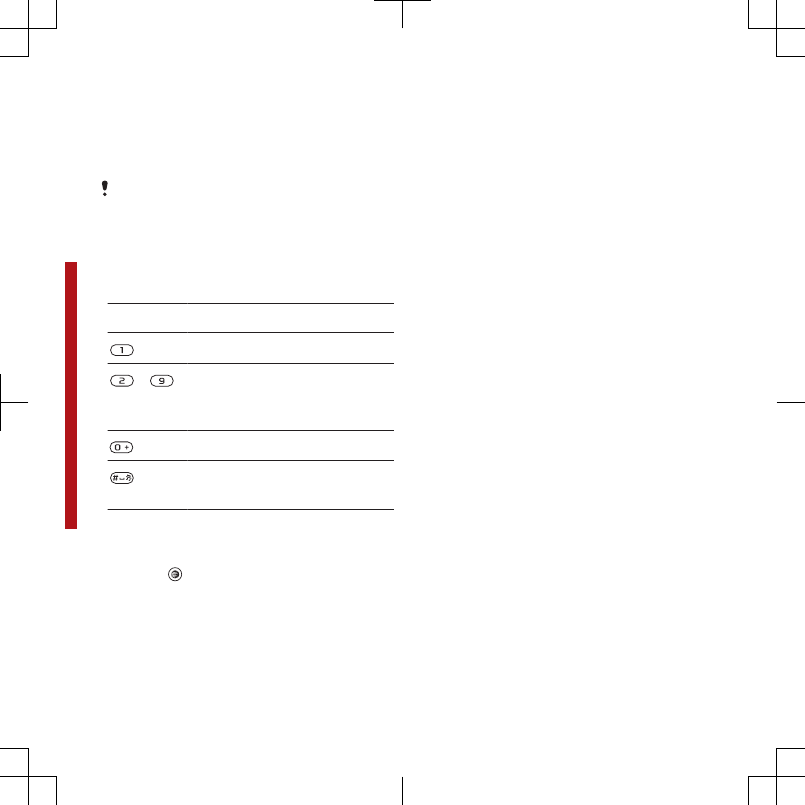
To send a link
1When you browse the Internet, select
Options > Tools > Send link.
2Select a transfer method.
Make sure the receiving device supports
the transfer method you select.
Internet keypad shortcuts
You can use the keypad to go directly
to an Internet browser function.
Key Shortcut
Bookmarks
- Enter text to Enter address,
Search Internet or search in
Bookmarks
Zoom
Pan & zoom (when Smart-Fit
is off)
To select Internet keypad shortcuts
1Select .
2Select Options > Advanced > Keypad
mode > Shortcuts.
Internet security and
certificates
Your phone supports secure browsing.
Certain Internet services, such as
banking, require certificates in your
phone. Your phone may already
contain certificates when you buy it or
you can download new certificates.
To view certificates in the phone
•Select Menu > Settings > General >
Security > Certificates.
MEdia™ Net 49
This is a draft publication for internal use only.

Synchronising
You can synchronise in two different
ways. You can synchronise your phone
using a computer program or you can
synchronise using an Internet service.
Use only one of the synchronisation
methods at a time with your phone.
For more information, go to
www.sonyericsson.com/support to
read the Synchronisation Feature
guide.
Synchronising using a
computer
You can use a USB cable or Bluetooth
wireless technology to synchronise
phone contacts, appointments,
bookmarks, tasks and notes with a
computer program such as Microsoft
Outlook®.
Before synchronising, you need to
install the Sony Ericsson PC Suite.
Sony Ericsson PC Suite software is
available for download at
www.sonyericsson.com/support
.
See Required operating systems on
page 27.
To download Sony Ericsson PC Suite
1Computer: In your Internet browser, go
to www.sonyericsson.com/support.
2Select a region and country.
3Select Software downloads.
4Select a phone from the list.
5Select Read more and download under
PC Suite.
6Select Download now and save the file
to your computer.
Remember where you save the file.
To install Sony Ericsson PC Suite from
the downloaded file
1Locate the downloaded Sony Ericsson
PC Suite file on the computer.
2Double-click the file and follow the
instructions.
To synchronise using the
Sony Ericsson PC Suite
1Computer: Start Sony Ericsson PC
Suite from Start/Programs/
Sony Ericsson/Sony Ericsson PC
Suite.
2Follow the instructions in the
Sony Ericsson PC Suite for how to
connect.
3Phone: Select Phone mode.
4Computer: When you are notified that
the Sony Ericsson PC Suite has found
50 Synchronising
This is a draft publication for internal use only.

your phone, you can start
synchronising.
For usage details, see the
Sony Ericsson PC Suite Help section
once the software has been installed on
your computer.
More features
Flight mode
In Flight mode the network and radio
transceivers are turned off to prevent
disturbance to sensitive equipment.
When the flight mode menu is activated
you are asked to select a mode the next
time you turn on your phone:
•Normal mode – full functionality
•Flight mode – limited functionality
To activate the flight mode menu
•Select Menu > Settings > General >
Flight mode > Continue > Show at
startup.
To select flight mode
1When the flight mode menu is
activated, turn off your phone.
2Turn on your phone and select Flight
mode.
Gesture control
When the phone is closed, you can
mute incoming calls or snooze alarms
with a hand gesture.
To use gesture control
•When a call comes in or the alarm rings,
a light appears adjacent to the camera.
More features 51
This is a draft publication for internal use only.

When the light appears, sweep your
hand back and forth once in front of the
camera lens to mute the call or snooze
the alarm.
The distance between your hand and the
camera lens must be 0–7 cm (0–3 inches).
To turn on gesture control
•Select Menu > Settings > General >
Gesture control > Turn on.
Alarms
You can set a sound or the radio as an
alarm signal. The alarm sounds even if
the phone is turned off. When the alarm
sounds you can silence it or turn it off.
To set the alarm
1Select Menu > Tools & Apps > Alarms.
2Scroll to an alarm and select Edit.
3Scroll to Time: and select Edit.
4Enter a time and select OK > Save.
To set the recurrent alarm
1Select Menu > Tools & Apps > Alarms.
2Scroll to an alarm and select Edit.
3Scroll to Recurrent: and select Edit.
4Scroll to a day and select Mark.
5To select another day, scroll to the day
and select Mark.
6Select Done > Save.
To set the alarm signal
1Select Menu > Tools & Apps > Alarms.
2Scroll to an alarm and select Edit.
3Scroll to the tab.
4Scroll to Alarm signal: and select Edit.
5Find and select an alarm signal. Select
Save.
To silence the alarm
•When the alarm sounds, press any key.
•To repeat the alarm, select Snooze.
To turn off the alarm
•When the alarm sounds, press any key,
then select Turn off.
To cancel the alarm
1Select Menu > Tools & Apps > Alarms.
2Scroll to an alarm and select Turn off.
The alarm in silent mode
You can set the alarm not to sound
when the phone is in silent mode.
To set an alarm to sound or not in
silent mode
1Select Menu > Tools & Apps > Alarms.
2Scroll to an alarm and select Edit.
3Scroll to the tab.
4Scroll to Silent mode: and select Edit.
5Select an option.
52 More features
This is a draft publication for internal use only.

To set the snooze duration
1Select Menu > Tools & Apps > Alarms.
2Scroll to an alarm and select Edit.
3Scroll to Snooze duration: and select
Edit.
4Select an option.
Calendar
You can synchronise your calendar with
a computer calendar, with a calendar on
the Web or with a Microsoft® Exchange
Server (Microsoft® Outlook®).
Appointments
You can add new appointments or
reuse existing appointments.
To add an appointment
1Select Menu > Tools & Apps >
Organiser > Calendar.
2Select a date.
3Scroll to New appointment and select
Add.
4Enter the information and confirm each
entry.
5Select Save.
To view an appointment
1Select Menu > Tools & Apps >
Organiser > Calendar.
2Select a date.
3Scroll to an appointment and select
View.
To edit an appointment
1Select Menu > Tools & Apps >
Organiser > Calendar.
2Select a date.
3Scroll to an appointment and select
View.
4Select Options > Edit.
5Edit the appointment and confirm each
entry.
6Select Save.
To set when reminders should sound
1Select Menu > Tools & Apps >
Organiser > Calendar.
2Select a date.
3Select Options > Advanced >
Reminders.
4Select an option.
A reminders option set in calendar affects
a reminders option set in tasks.
Notes
You can make notes and save them.
You can also show a note in standby.
To add a note
1Select Menu > Tools & Apps >
Organiser > Notes.
2Scroll to New note and select Add.
More features 53
This is a draft publication for internal use only.

3Write a note and select Save.
To show a note in standby
1Select Menu > Tools & Apps >
Organiser > Notes.
2Scroll to a note and select Options >
Show in standby.
To hide a note from standby
1Select Menu > Tools & Apps >
Organiser > Notes.
2Scroll to the note shown in standby.
This is marked with an icon. Select
Options > Hide in standby.
Tasks
You can add new tasks or reuse
existing tasks.
To add a task
1Select Menu > Tools & Apps >
Organiser > Tasks.
2Select New task and select Add.
3Select an option.
4Enter details and confirm each entry.
To set when reminders should sound
1Select Menu > Tools & Apps >
Organiser > Tasks.
2Scroll to a task and select Options >
Reminders.
3Select an option.
A reminders option set in tasks affects a
reminders option set in calendar.
Profiles
You can change settings such as the
ring volume and vibrating alert to suit
different locations. You can reset all
profiles to the phone’s original settings.
To select a profile
1Select Menu > Settings > General >
Profiles.
2Select a profile.
To view and edit a profile
1Select Menu > Settings > General >
Profiles.
2Scroll to a profile and select Options >
View and edit.
You cannot rename the Normal profile.
Time and date
To set the time
1Select Menu > Settings > General >
Time & date > Time.
2Enter the time and select Save.
To set the date
1Select Menu > Settings > General >
Time & date > Date.
2Enter the date and select Save.
54 More features
This is a draft publication for internal use only.

To set the time zone
1Select Menu > Settings > General >
Time & date > My time zone.
2Select the time zone you are in.
If you select a city, My time zone also
updates the time when daylight saving
time changes.
To change the clock size of the
standby screen
1Select Menu > Settings > Display >
Clock size.
2Select an option.
Theme
You can change the appearance of the
screen through items such as colours
and wallpaper. You can also create
new themes and download them. For
more information, go to
www.sonyericsson.com/fun.
To set a theme
1Select Menu > Settings > Display >
Theme.
2Scroll to a theme and select Set.
Main menu layout
You can change the layout of the icons
in the main menu.
To change the main menu layout
1Select Menu > Options > Main menu
layout.
2Select an option.
Ringtones
To set a ringtone
1Select Menu > Settings > Sounds &
alerts > Ringtone.
2Find and select a ringtone.
To set the ringtone volume
•Use the side volume keys to raise or
lower the volume.
To turn off the ringtone
•Press and then press and hold
down .
The alarm signal is not affected.
To set the vibrating alert
1Select Menu > Settings > Sounds &
alerts > Vibrating alert.
2Select an option.
Screen orientation
You can change between landscape
and portrait orientation, or select Auto
rotate to have the orientation change
when you rotate the phone.
More features 55
This is a draft publication for internal use only.

To change screen orientation in the
browser
1Select .
2Select Options > View.
3Select Landscape or Portrait.
To change screen orientation in
Media
1Select Menu > Entertainment >
Settings > Orientation.
2Select an option.
Games
Your phone contains preloaded
games. You can also download games.
For more information, go to
www.sonyericsson.com/fun. Help
texts are available for most games.
To start a game
1Select Menu > Entertainment > Games.
2Select a game.
To end a game
•Press .
Applications
You can download and run Java
applications. You can also view
information or set different
permissions.
To select a Java application
1Select Menu > Tools & Apps >
Applications.
2Select an application.
Java application screen size
Some Java applications are designed
for a specific screen size. For more
information, contact the application
vendor.
To set the screen size for a Java
application
1Select Menu > Tools & Apps >
Applications.
2Scroll to an application and select
Options > Screen size.
3Select an option.
To set a Java™ application as a
wallpaper
1Select Menu > Settings > Display.
2Select Wallpaper > Application.
3Select a Java application.
You can only see the Java applications
that have support for wallpaper.
Locks
SIM card lock
This lock only protects your
subscription. Your phone will work with
56 More features
This is a draft publication for internal use only.

a new SIM card. If the lock is on, you
have to enter a PIN (Personal Identity
Number).
If you enter your PIN incorrectly three
times in a row, the SIM card is blocked
and you need to enter your PUK
(Personal Unblocking Key). Your PIN
and PUK are supplied by AT&T.
To unblock the SIM card
1When PIN blocked appears, enter your
PUK and select OK.
2Enter a new four-to-eight-digit PIN and
select OK.
3Re-enter the new PIN and select OK.
To edit the PIN
1Select Menu > Settings > General >
Security > Locks > SIM protection >
Change PIN.
2Enter your PIN and select OK.
3Enter a new four-to-eight-digit PIN and
select OK.
4Re-enter the new PIN and select OK.
If Codes do not match appears, you
entered the new PIN incorrectly. If Wrong
PIN appears, followed by Old PIN:, you
entered your old PIN incorrectly.
To use the SIM card lock
1Select Menu > Settings > General >
Security > Locks > SIM protection >
Protection.
2Select an option.
3Enter your PIN and select OK.
Phone lock
You can stop unauthorised use of your
phone. Change the phone lock code
(0000) to any four-to-eight-digit
personal code.
It is important that you remember your
new code. If you forget it, you have to take
your phone to your local Sony Ericsson
retailer.
To use the phone lock
1Select Menu > Settings > General >
Security > Locks > Phone protection >
Protection.
2Select an option.
3Enter the phone lock code and select
OK.
To unlock the phone
•Enter your code and select OK.
To change the phone lock code
1Select Menu > Settings > General >
Security > Locks > Phone protection >
Change code.
More features 57
This is a draft publication for internal use only.

2Enter the old code and select OK.
3Enter the new code and select OK.
4Repeat the code and select OK.
Password Saver
You can save security codes, for
example, for credit cards. You must set
a passcode to open the Password
Saver.
Checkword
The checkword confirms that you have
entered the correct passcode. If the
passcode is correct, the correct codes
are shown. If the passcode is incorrect,
the checkword and the codes shown
are also incorrect.
To open Password Saver for the first
time
1Select Menu > Tools & Apps >
Organiser > Password Saver.
2Follow the instructions that appear and
select Continue.
3Enter a passcode and select Continue.
4Confirm the passcode and select
Continue.
5Enter a checkword and select Done.
To add a code
1Select Menu > Tools & Apps
>Organiser > Password Saver.
2Enter a passcode and select Continue.
3Scroll to New code and select Add.
4Enter a name associated with the code
and select Continue.
5Enter the code and select Done.
To change a passcode
1Select Menu > Tools & Apps
>Organiser > Password Saver.
2Enter your passcode and select OK.
3Select Options > Change passcode.
4Enter your new passcode and select
OK.
5Re-enter the new passcode and select
OK.
Forget your passcode?
If you forget your passcode, you must
reset the Password Saver. This means
that all entries in the Password Saver
are deleted. The next time you enter the
Password Saver, you must proceed as
if you are opening it for the first time.
See To open Password Saver for the
first time on page 58.
IMEI number
Keep a copy of your IMEI (International
Mobile Equipment Identity) number in
case your phone is stolen.
58 More features
This is a draft publication for internal use only.
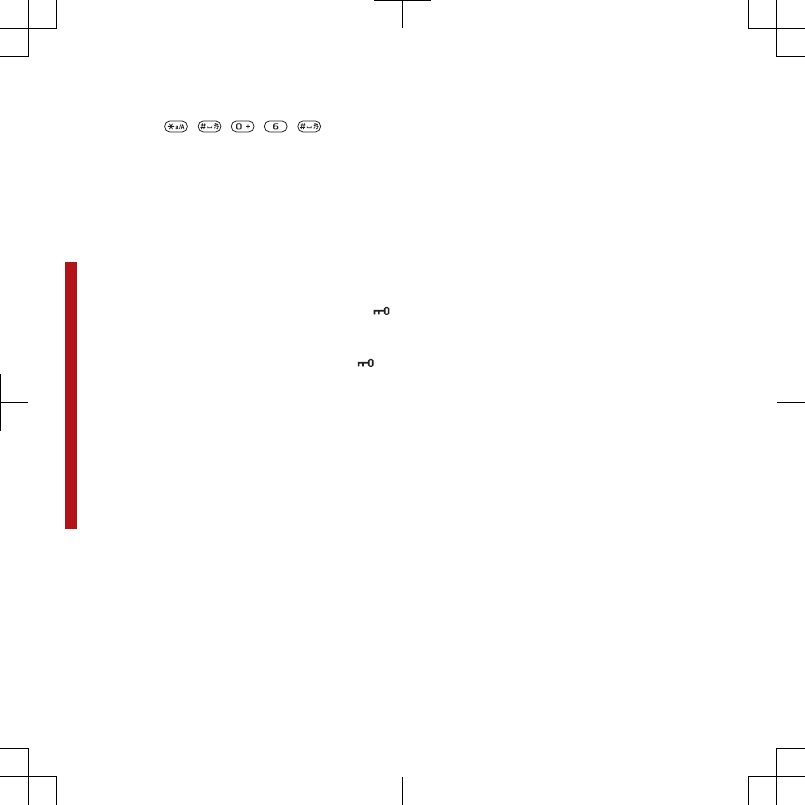
To view your IMEI number
•Press , , , , .
Using the flip
When the phone is closed, you can use
the media player keys on the flip to
control your Walkman™ player or
radio. You can lock these keys to avoid
accidental touch.
To unlock the media player keys
•Slide the keylock switch away from .
To lock the media player keys
•Slide the keylock switch towards .
Troubleshooting
Some problems will require you to call
AT&T.
For more support go to
www.sonyericsson.com/support.
Common questions
I have problems with memory
capacity or the phone is working
slowly
Restart your phone every day to free
memory or do a Master reset.
Master reset
If you select Reset settings, the
changes that you have made to
settings will be deleted.
If you select Reset device, your settings
and content, such as contacts,
messages, pictures, sounds and
downloaded games, will be deleted.
You may also lose content that was in
the phone at purchase.
To reset the phone
1Select Menu > Settings > General >
Master reset.
2Select an option.
3Follow the instructions that appear.
Troubleshooting 59
This is a draft publication for internal use only.

I cannot charge the phone or battery
capacity is low
The charger is not properly connected
or the battery connection is poor.
Remove the battery and clean the
connectors.
The battery is worn out and needs to be
replaced. See Charging the battery on
page 7.
No battery icon appears when I start
charging the phone
It may take a few minutes before the
battery icon appears on the screen.
Some menu options appear in grey
A service is not activated. Contact your
network operator.
I cannot use Internet-based services
Your subscription does not include
data capability. Settings are missing or
incorrect.
You can download settings using the
setup wizard or by going to
www.sonyericsson.com/support.
To download settings
1Select Menu > Settings > User help >
Settings download.
2Follow the instructions that appear.
Contact your network operator or service
provider for more information.
I cannot send messages from my
phone
Most messages require a service
centre number to send them. The
number is supplied by AT&T and is
usually saved on the SIM card. If the
number to your service centre is not
saved on your SIM card, you must
enter the number yourself. To send
most picture messages, you must set
an MMS profile and the address of your
message server.
To send most multimedia messages,
you must set an MMS profile and the
address of your message server. If no
MMS profile or message server exists,
you may be able to obtain the settings
automatically from AT&T or
atwww.sonyericsson.com/support.
To enter a service centre number
1Select Menu > Settings > Connectivity >
Message settings > Text Message and
scroll to Service centre. The number is
shown if it is saved on the SIM card.
2If there is no number shown, select
Edit.
3Scroll to New ServiceCentre and select
Add.
60 Troubleshooting
This is a draft publication for internal use only.

4Enter the number, including the
international “+” sign and country
code.
5Select Save.
To select an MMS profile
1Select Menu > Settings > Connectivity >
Message settings > Multimedia Msg.
2Select an existing profile or create a
new one.
To set the message server address
1Select Menu > Settings > Connectivity >
Message settings > Multimedia Msg.
2Scroll to a profile and select Options >
Edit.
3Scroll to Message server and select
Edit.
4Enter the address and select OK >
Save.
The phone does not ring or rings too
softly
Make sure that Silent mode has not
been set to On. See To turn off the
ringtone on page 55.
Check the ringtone volume. See To set
the ringtone volumeon page 55.
Check the profile. See To select a
profile on page 54.
Check the divert call options. See To
divert calls on page 36.
The phone cannot be detected by
other devices using Bluetooth
wireless technology
You have not turned the Bluetooth
function on. Make sure that the visibility
is set to Show phone. See To turn on
the Bluetooth function on page 28.
I cannot synchronise or transfer
content between my phone and my
computer, when using a USB cable.
The cable or software has not been
properly installed. Go to
www.sonyericsson.com/support to
read Feature guides which contain
detailed installation instructions and
troubleshooting sections.
I have forgotten my code memo
passcode
If you forget your passcode, you must
reset the code memo. This means that
all entries in the code memo are
deleted. The next time you enter the
code memo, you must proceed as if
you are opening it for the first time.
To reset Password Saver
1Select Menu > Tools & Apps >
Organiser > Password Saver.
Troubleshooting 61
This is a draft publication for internal use only.
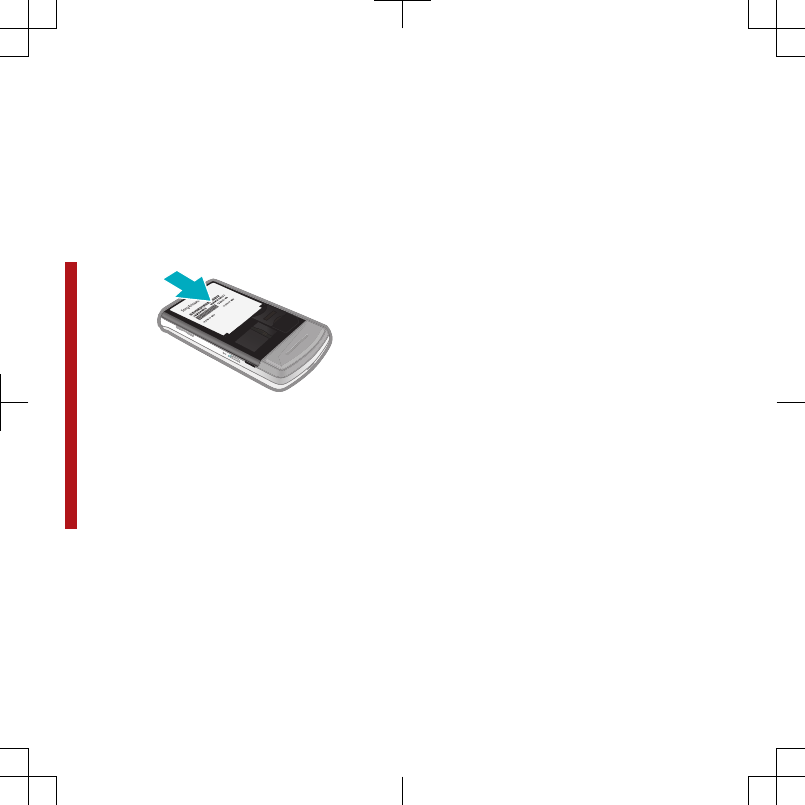
2Enter an incorrect passcode three
times.
3Reset Password Saver and delete all
items? appears.
4Select Yes.
Where can I find the regulatory
information such as my IMEI number
if I cannot turn on my phone?
Error messages
Insert SIM
There is no SIM card in your phone or
you may have inserted it incorrectly.
See To insert the SIM card on page 6.
The SIM card connectors need
cleaning. If the card is damaged,
contact AT&T.
Insert correct SIM card
Your phone is set to work only with
certain SIM cards. Check if you are
using the correct operator SIM card.
Wrong PIN/Wrong PIN2
You have entered your PIN or PIN2
incorrectly.
Enter the correct PIN or PIN2 and
select Yes.
PIN blocked/PIN2 blocked
You have entered your PIN or PIN2
code incorrectly three times in a row.
To unblock, see SIM card lock on
page 56.
Codes do not match
Codes that you have entered do not
match. When you want to change a
security code, for example your PIN,
you have to confirm the new code. See
SIM card lock on page 56.
No netw. coverage
Your phone is in flight mode. See Flight
mode on page 51.
Your phone is not receiving any
network signal, or the received signal is
too weak. Contact AT&T and make
sure that the network has coverage
where you are.
The SIM card is not working properly.
Insert your SIM card in another phone.
If this works, it is probably your phone
62 Troubleshooting
This is a draft publication for internal use only.

that is causing the problem. Please
contact the nearest Sony Ericsson
service location.
Emerg. calls only
You are within range of a network, but
you are not allowed to use it. However,
in an emergency, some network
operators allow you to call the
international emergency number 112.
See Emergency calls on page 31.
PUK blocked. Contact operator.
You entered your personal unblocking
key code (PUK) incorrectly 10 times in
a row.
Hearing Aid
Compatibility
Your phone is designed for Hearing Aid
Compatibility (HAC) and uses settings
to optimize its use with hearing aids.
Hearing Aid Settings
You can choose the setting in the
phone to match the setting in your
hearing aid before making or receiving
calls.
To select a phone setting for HAC
•Select Menu > Settings > General >
Accessibility > Hearing aid and choose
an option:
•On – Use when your hearing aid is set
to T-coil mode.
•Off – Use when your hearing aid is set
to Microphone mode.
Hearing Aid Compatibility and
New Technologies
This phone has been tested and rated
for use with hearing aids for some of the
wireless technologies that it uses.
However, there may be some newer
wireless technologies used in this
phone that have not been tested yet for
use with hearing aids. It is important to
Hearing Aid Compatibility 63
This is a draft publication for internal use only.

try the different features of this phone
thoroughly and in different locations,
using your hearing aid or cochlear
implant, to determine if you hear any
interfering noise. Consult your service
provider about its return and exchange
policies and for information on hearing
aid compatibility.
Hearing Aid Compatibility
Rating
This model handset was designed to
comply with the requirements set forth
in Section 20.19 of the Federal
Communication Commission's (FCC)
rules governing hearing aid
compatibility (HAC), for the reduction
of RF interference and magnetic
coupling (T-coil) to hearing aids. The
Microphone (M) rating and T-coil (T)
rating is defined and labeled on the
handset box. Devices meeting HAC
compliance must have a minimum M3
and/or T3 rating or above as defined by
the FCC in accordance with the latest
ANSI Standard C63.19. The (M) rating
refers to lower RF emission levels of the
handset. The (T) rating refers to the
magnetic coupling between the
handset and the T-coil compatible
hearing aid. Some hearing aids are also
provided an (M) rating, and are more
immune than others to interference. To
determine the (M) rating of your hearing
aid, please contact your hearing health
professional. More information about
digital wireless devices and hearing aid
compatibility can be found at
www.sonyericsson-snc.com.
64 Hearing Aid Compatibility
This is a draft publication for internal use only.

Index
A
activity menu ........................................14
Address Book .......................................32
alarms ...................................................52
answering service .................................36
applications ..........................................56
appointments .......................................53
assembly ................................................6
AT&T Video Share ................................32
audio book ...........................................19
auto rotate ............................................55
B
backing up and restoring .....................29
battery
capacity ..........................................7
charging .........................................8
inserting ..........................................6
Bluetooth™ wireless technology .........28
bookmarks ...........................................48
business card .......................................35
C
calendar ................................................53
call divert ..............................................36
call list ..................................................32
call numbers in message ......................40
caller-specific ringtones .......................33
calls accepting .....................................38
answering and rejecting ...............31
emergency ...................................31
handling two calls ........................37
international ..................................30
making and receiving ...................30
putting on hold .............................37
recording ......................................22
camera .................................................43
printing .........................................47
code memo ..........................................61
conference calls ...................................37
contacts
adding phone contacts ................33
default contacts ...........................32
groups ..........................................35
Smart search ................................33
costs .......................................................7
D
date ......................................................54
download
settings .........................................60
E
emergency numbers ............................31
entering text .........................................15
F
file manager ..........................................23
flight mode ...........................................51
Index 65
This is a draft publication for internal use only.

flip locking ..........................................59
unlocking ......................................59
FM radio ...............................................21
G
games ...................................................56
gesture control .....................................51
groups ..................................................35
H
handsfree .......................................16, 36
Bluetooth™ wireless technology . 29
hearing aid compatibility ......................64
help .........................................................7
hiding number ......................................38
I
IM .........................................................41
imaging .................................................43
IMEI number .........................................58
instant messaging ................................41
Internet
bookmarks ...................................48
screen orientation ........................56
security and certificates ...............49
settings .........................................60
K
keys ........................................................9
L
language ...............................................15
lock phone ...........................................57
SIM card .......................................56
locking
flip .................................................59
M
master reset .........................................59
Media Go™ ..........................................26
media transfer ......................................27
MEdia™ Net .........................................48
memory ................................................14
memory card ........................................15
memory status .....................................34
menu overview .....................................11
messages
text and picture ............................39
voice .............................................41
messaging
instant ...........................................41
microphone ..........................................31
MMS See multimedia messages
Mobile Email .........................................41
model name ...........................................7
multimedia messages ..........................39
MusicDJ™ ............................................22
MusicID™ .............................................20
my phone number ..................................7
66 Index
This is a draft publication for internal use only.

N
navigating menus .................................13
notes ....................................................53
P
pan and zoom
Web pages ...................................48
password saver ....................................58
PC Suite ...............................................50
phone memory .................................7, 14
phone mode .........................................50
phone name .........................................28
phone, turning on ...................................6
photo fix ...............................................45
PhotoDJ™ ............................................46
photos ..................................................45
editing ..........................................46
improving .....................................45
tags ..............................................46
pictures ................................................45
PIN ....................................................7, 57
playlists ................................................18
power saving ........................................29
profiles ..................................................54
PUK ......................................................56
R
recording
listening to ....................................22
ringtones ..............................................55
setting ..........................................55
roaming ..................................................7
S
screen orientation ...........................55, 56
search
on Web pages ..............................48
selection keys .......................................13
SensMe™ .............................................19
setting
ringtones ......................................55
settings
download .....................................60
settings, Internet ..................................60
shake control ........................................17
shortcuts ..............................................14
SIM card
copying to/from ............................34
inserting ..........................................6
lock and unblock ..........................56
SMS See text messages
SOS See emergency numbers
sound recorder .....................................22
speed dialling .......................................35
standby ..................................................7
notes ............................................54
synchronising .......................................50
T
T9™ Text Input .....................................16
tagging photos .....................................45
tasks .....................................................54
templates ..............................................40
theme ...................................................55
time ................................................54, 55
Index 67
This is a draft publication for internal use only.

time zone ..............................................55
TrackID™ .............................................20
transfer method
Bluetooth™ wireless technology . 28
USB cable ....................................24
transferring
music ............................................26
photos ..........................................26
sound ...........................................29
turning on/off
Bluetooth™ function ....................28
phone lock ....................................57
SIM lock protection ......................57
U
USB cable ............................................24
V
video editing .........................................46
video player ..........................................20
video recorder ......................................43
video ringtones .....................................55
Video Share ..........................................32
VideoDJ™ ............................................46
voice control .........................................36
voice messages ....................................41
voicemail ..............................................36
volume
ear speaker ..................................31
W
Walkman™ player ..........................16, 17
Web pages
history ...........................................48
Z
zoom ....................................................44
68 Index
This is a draft publication for internal use only.